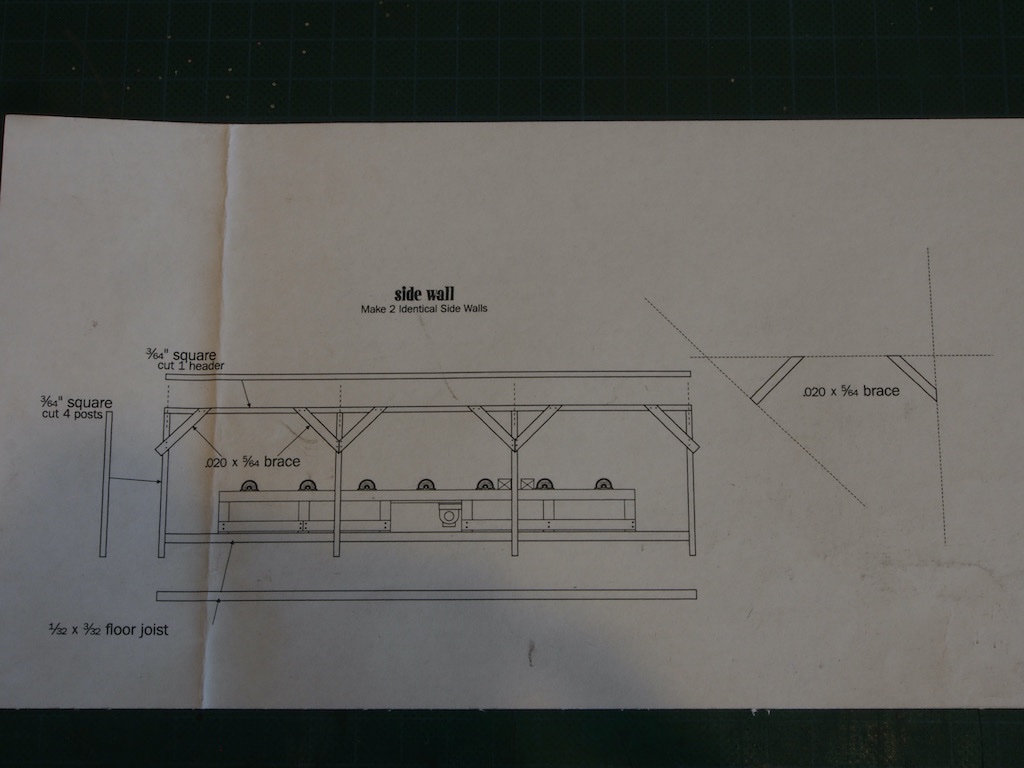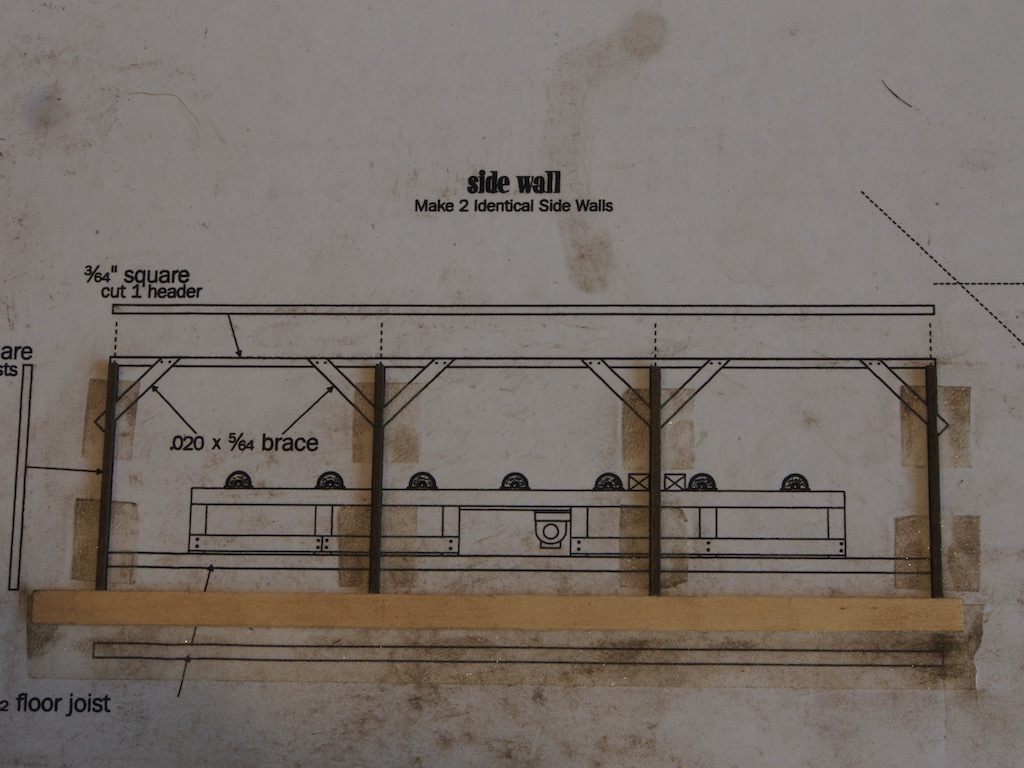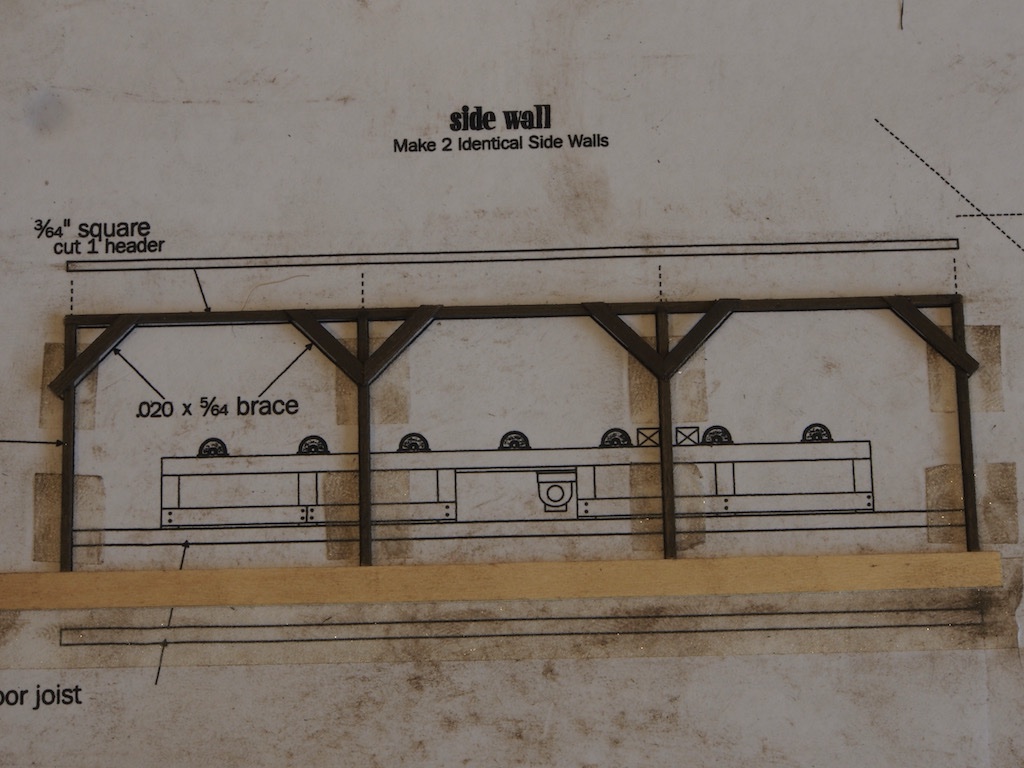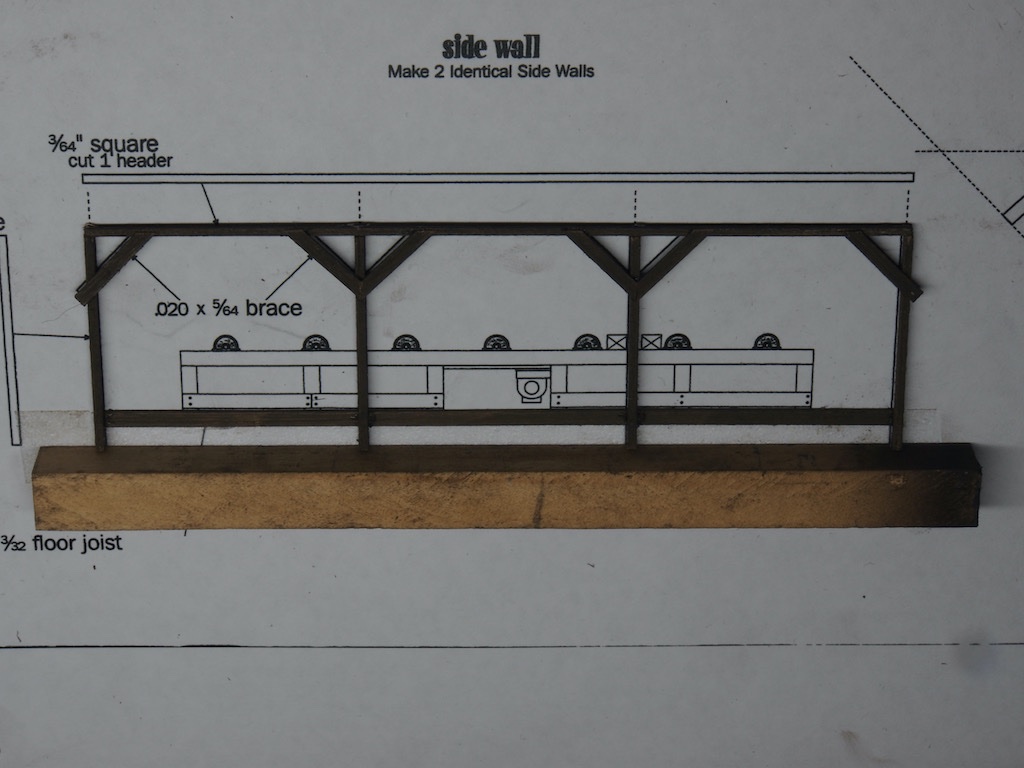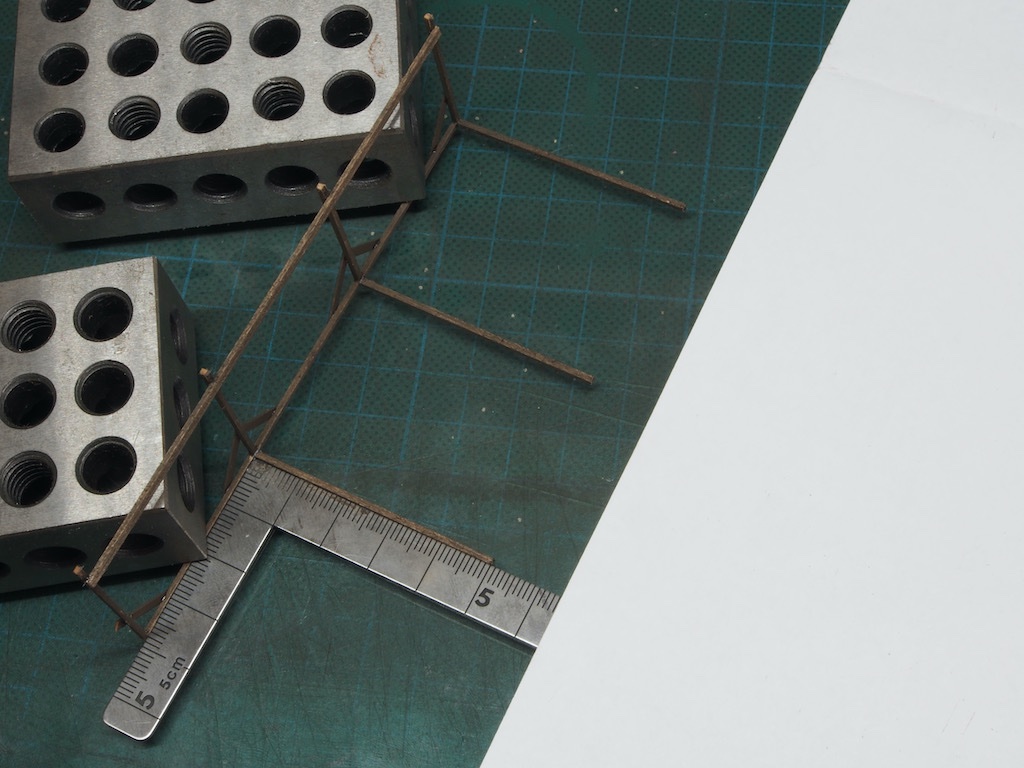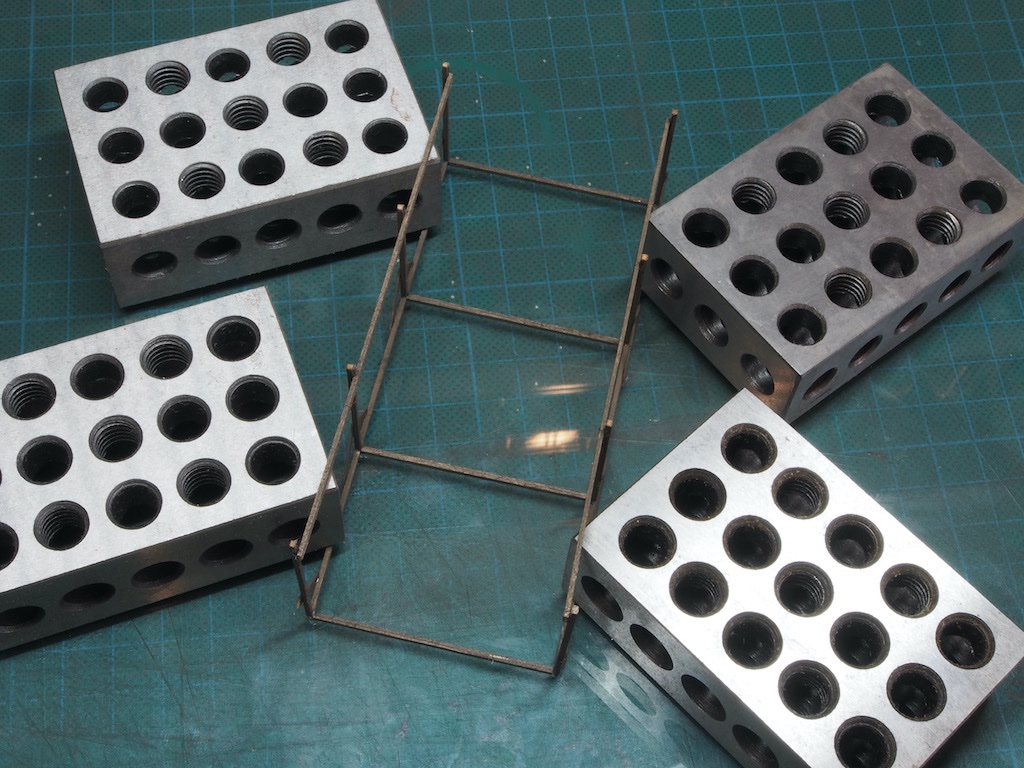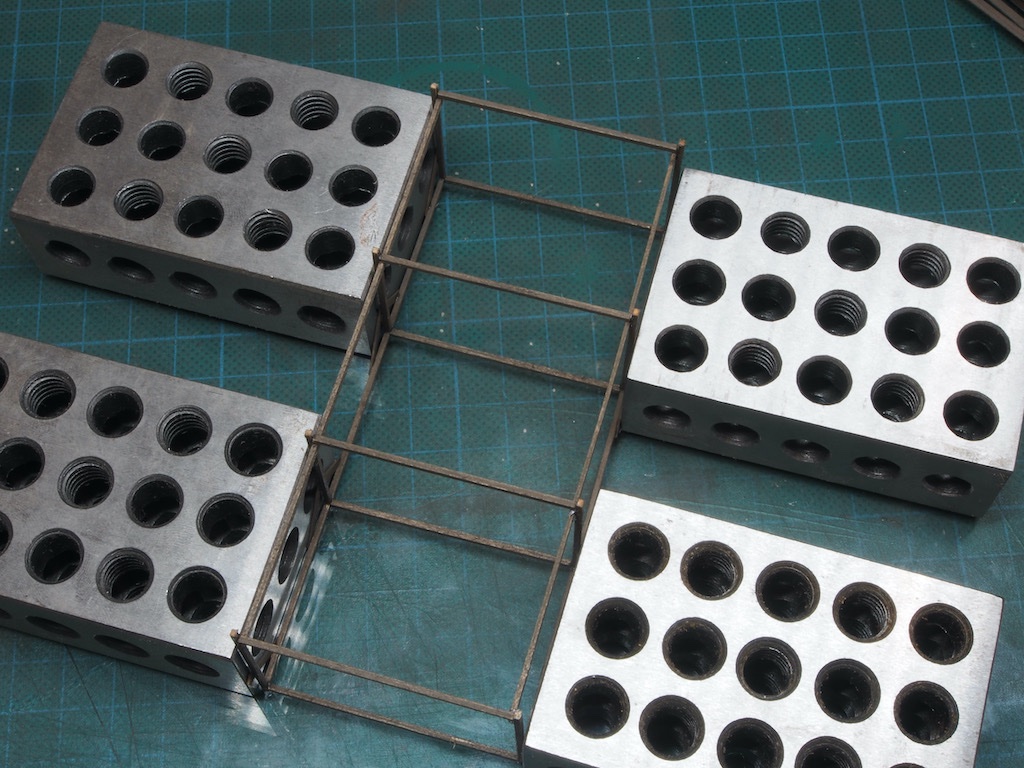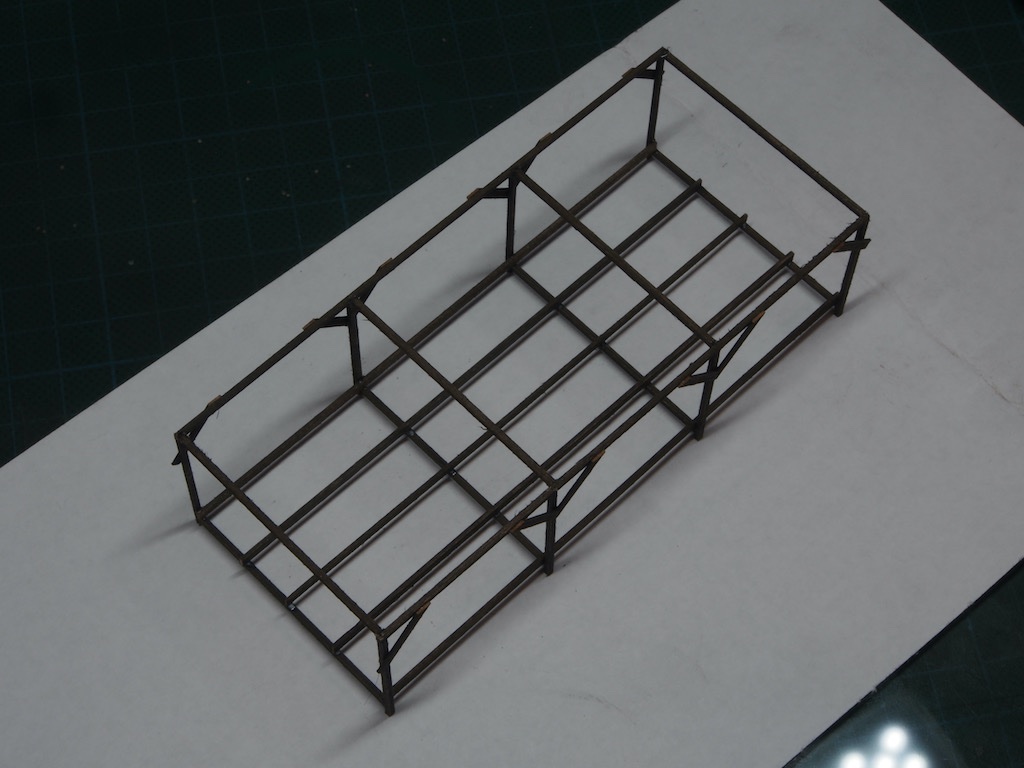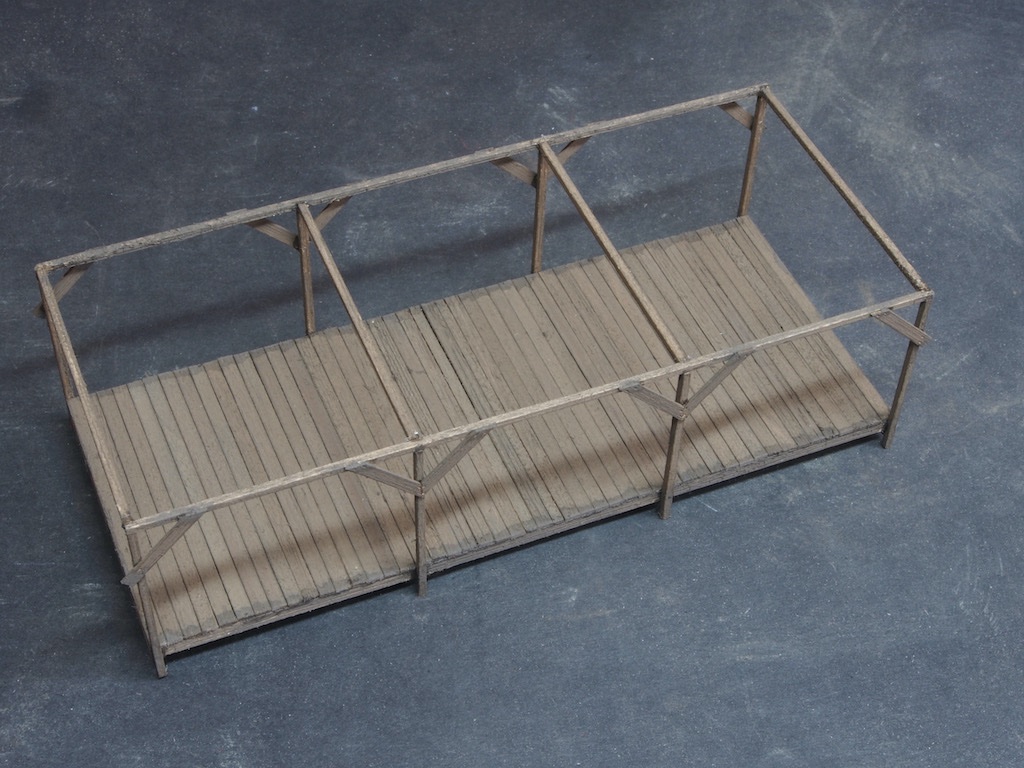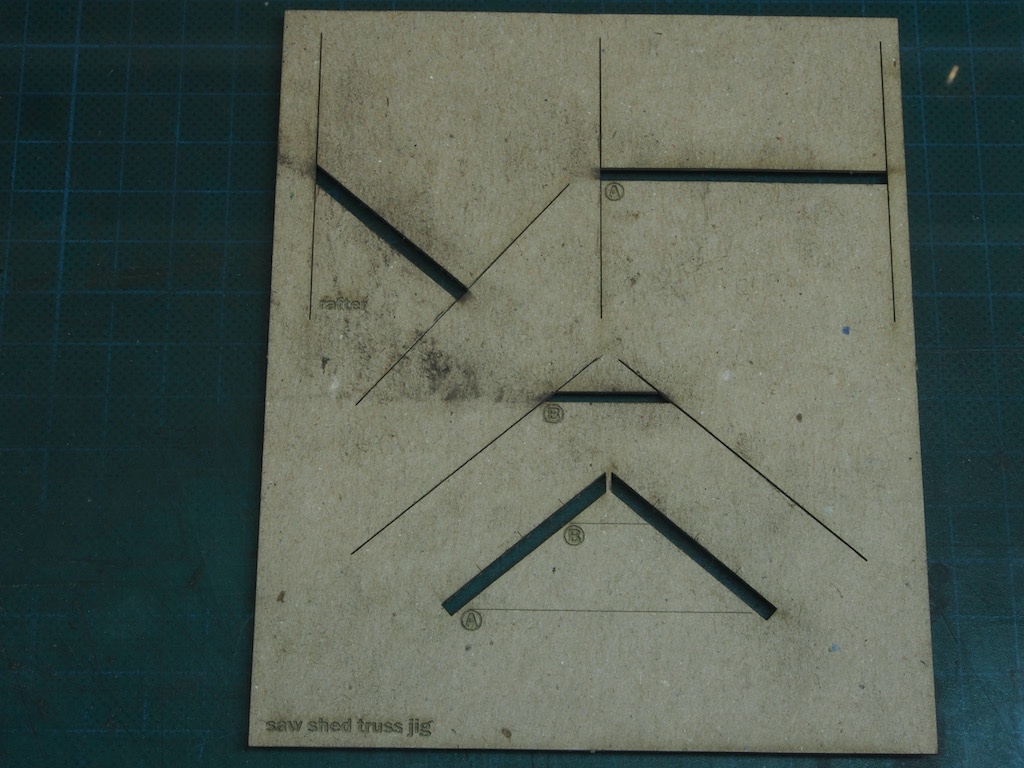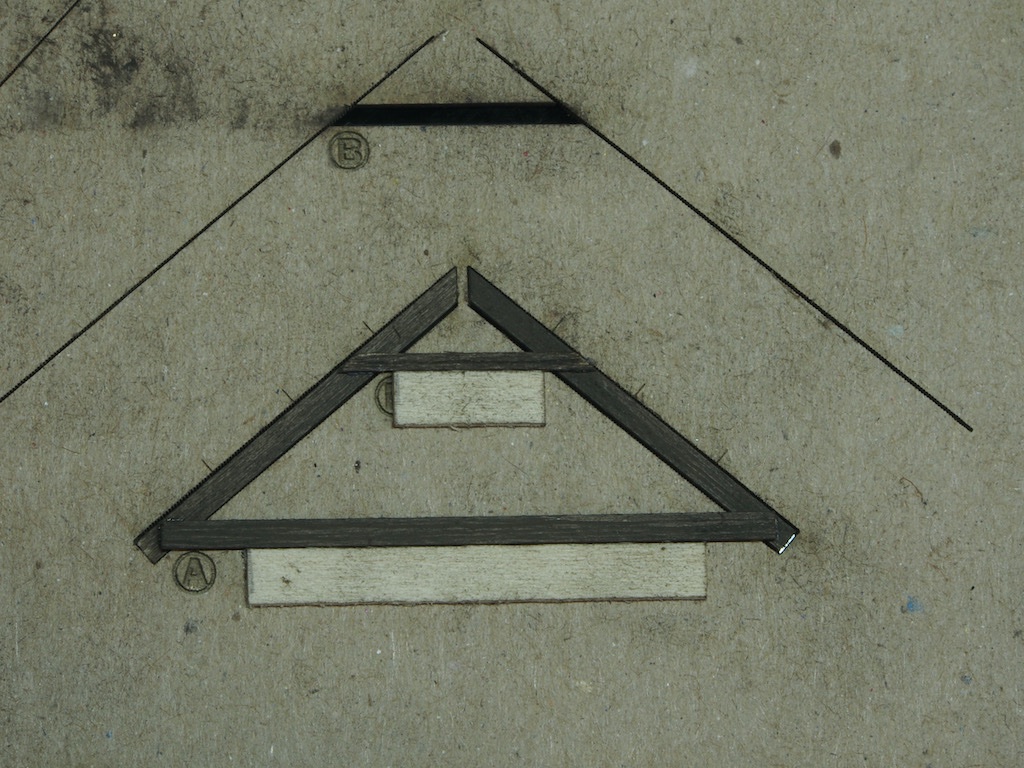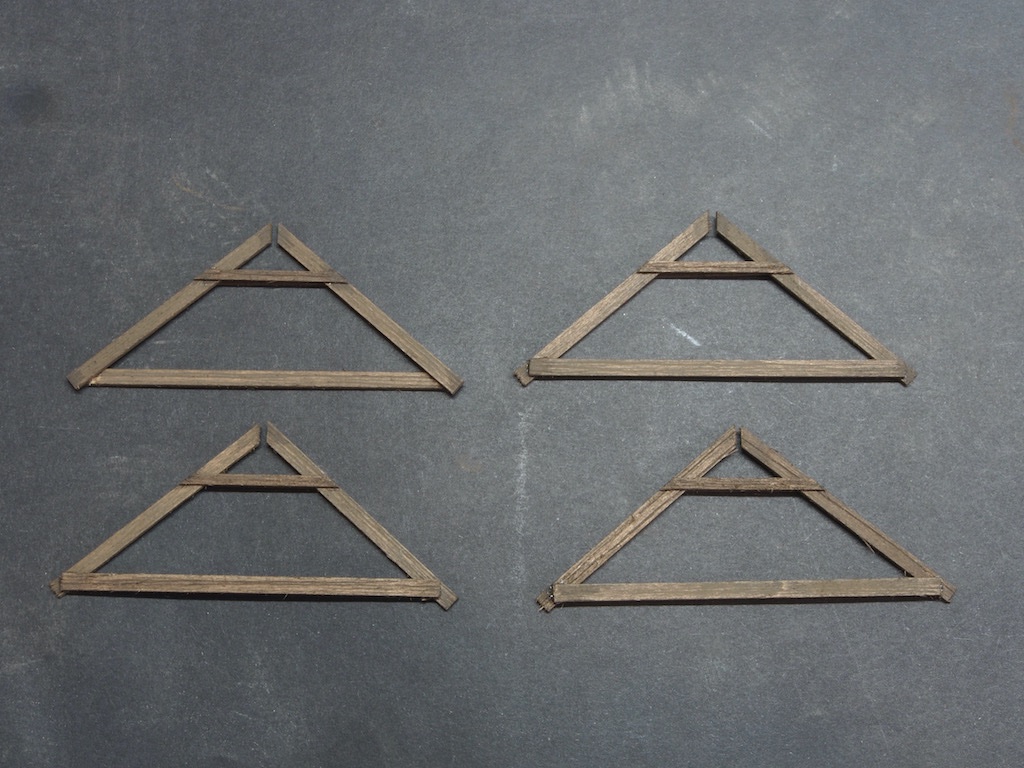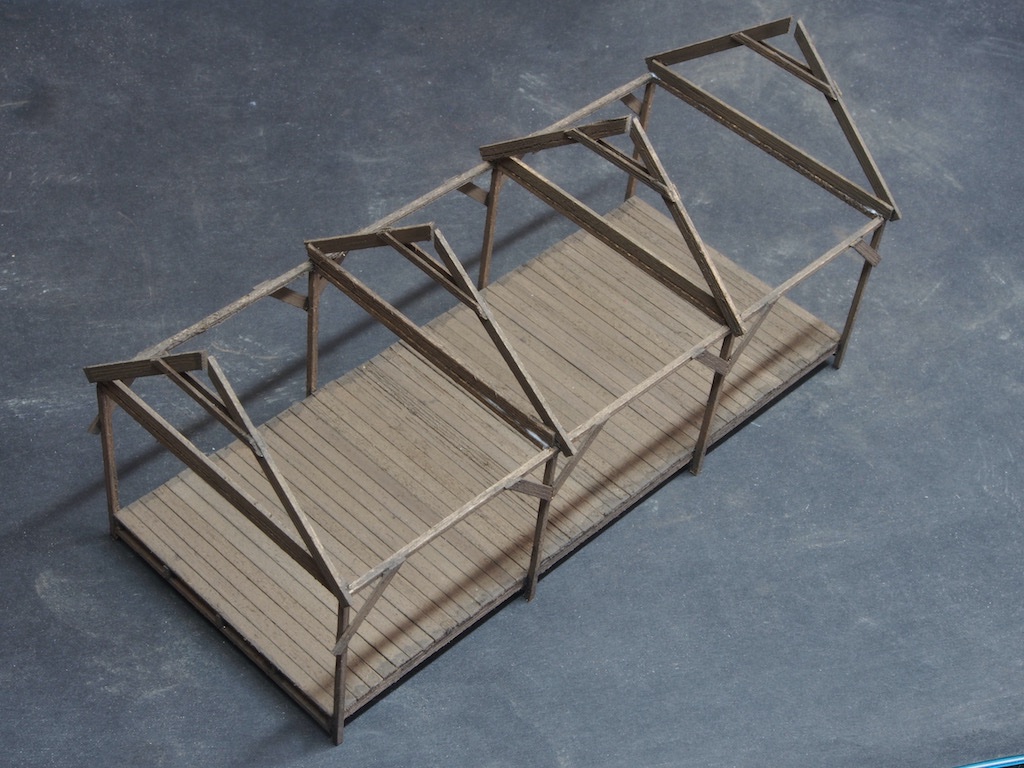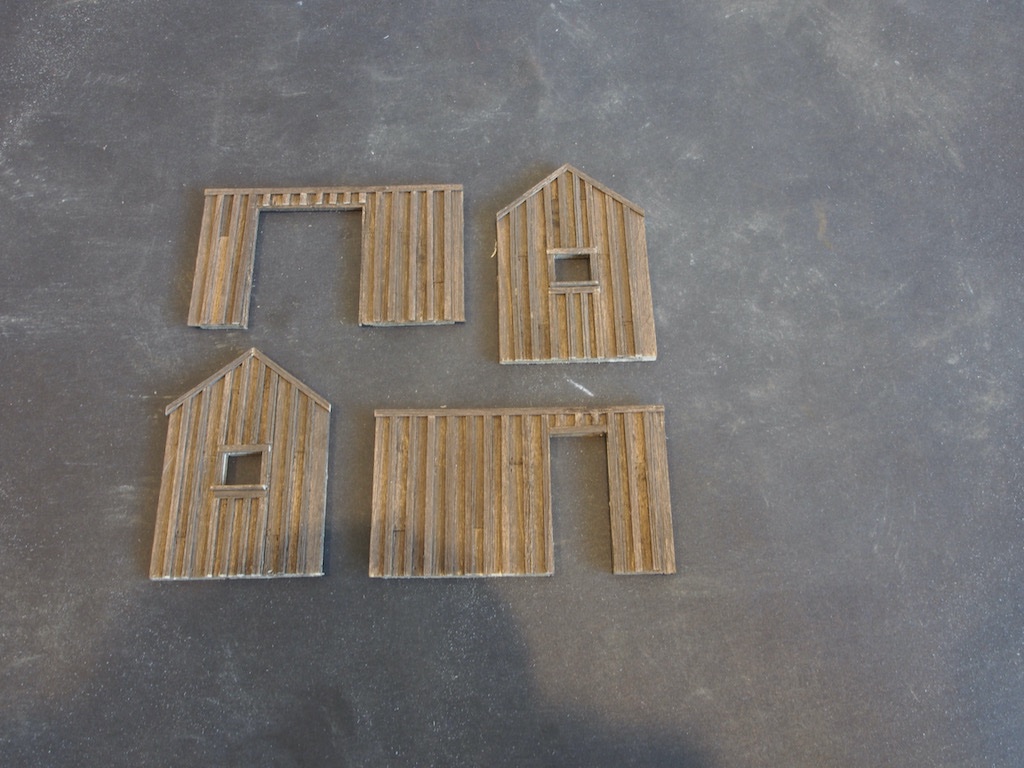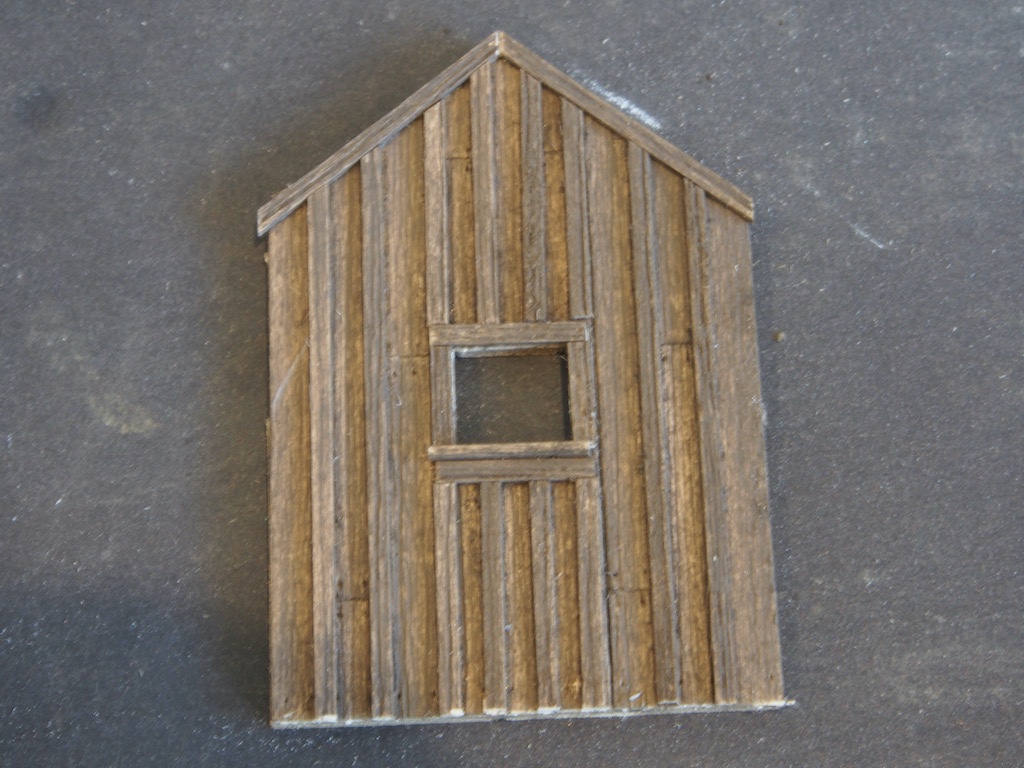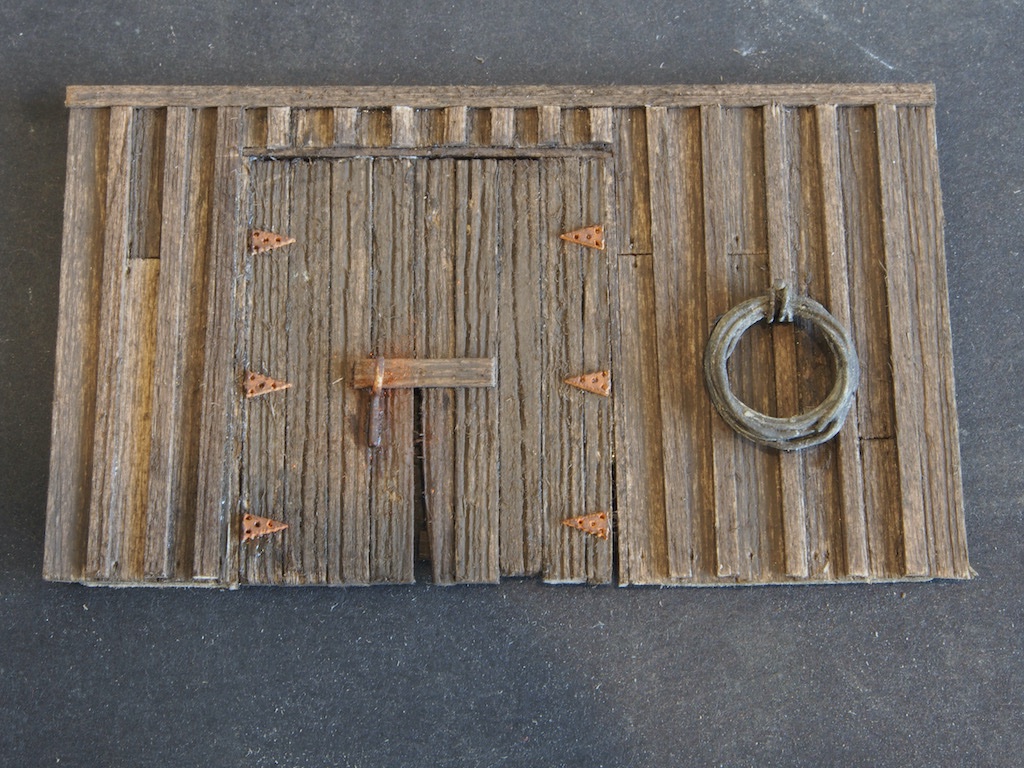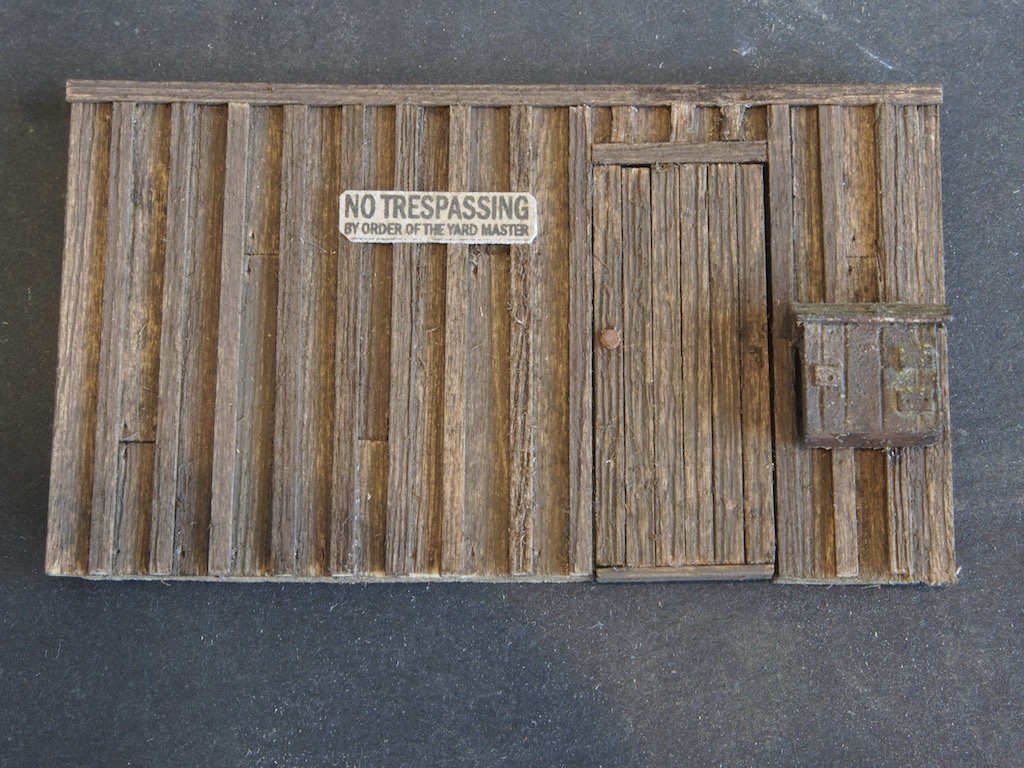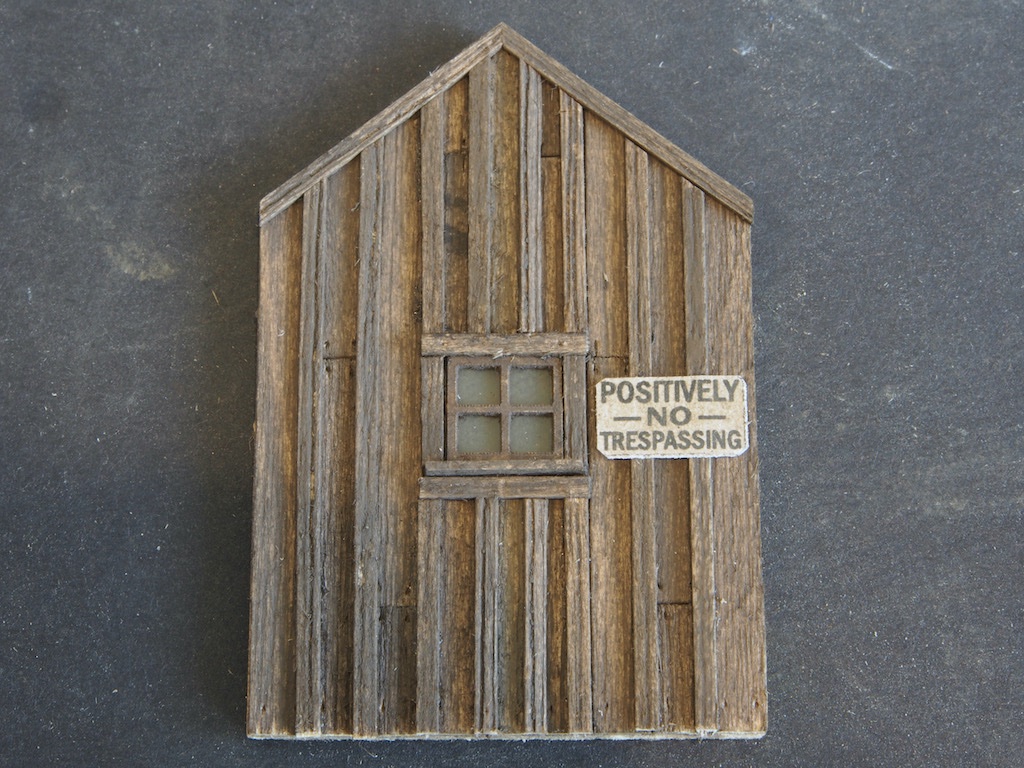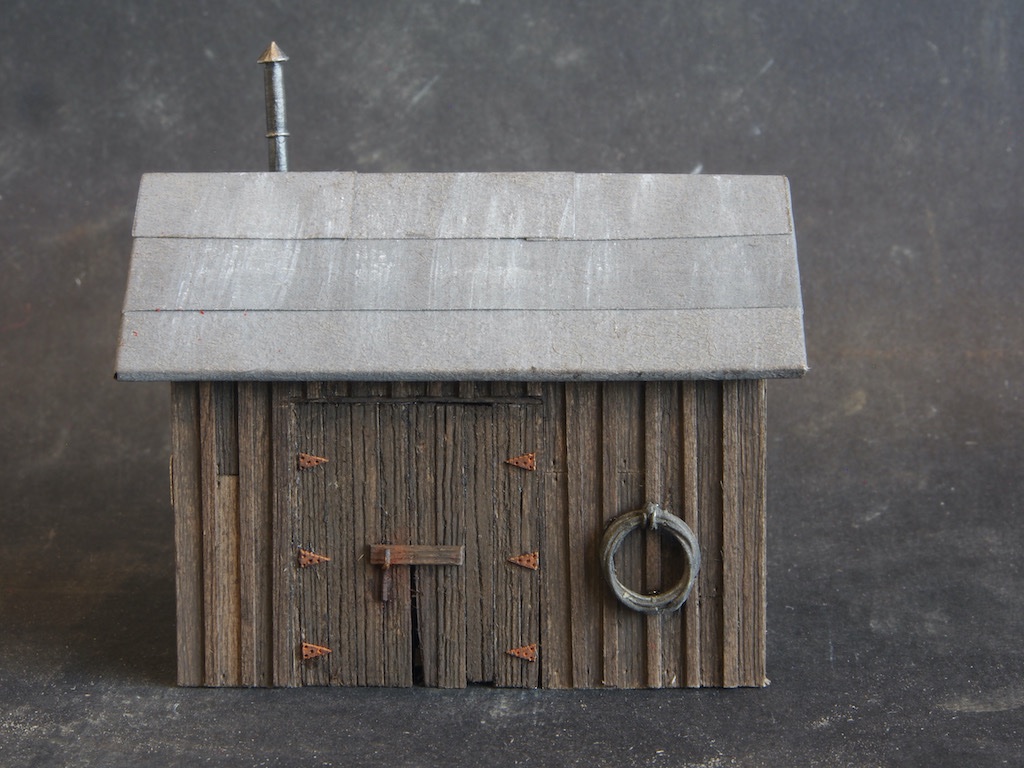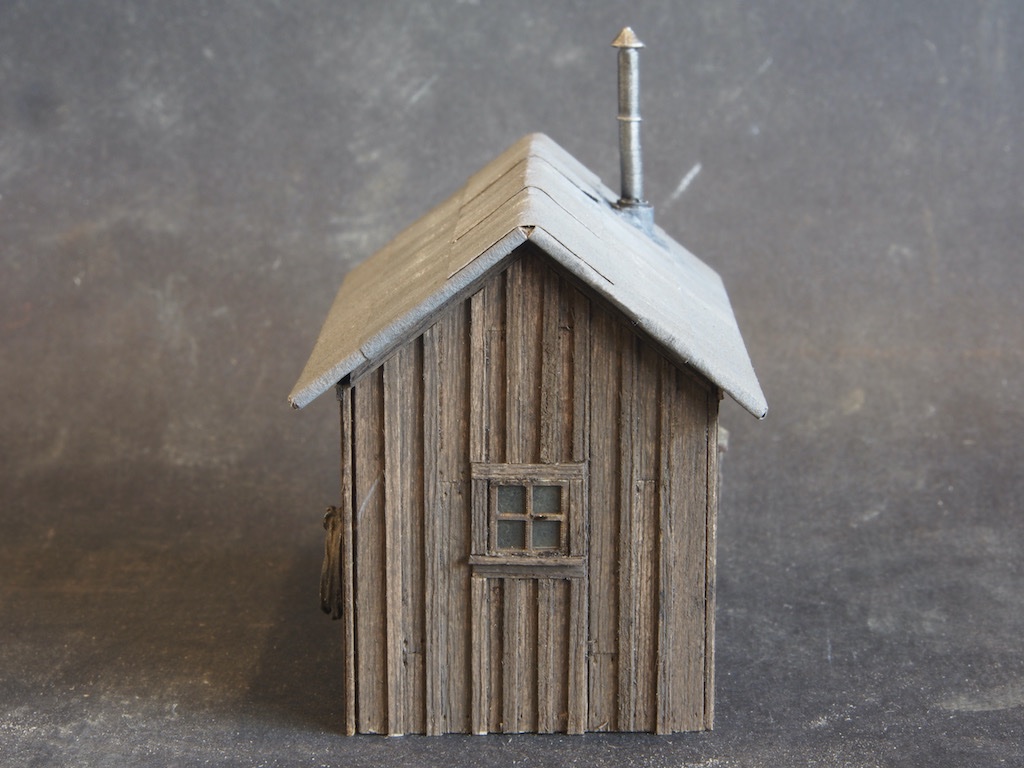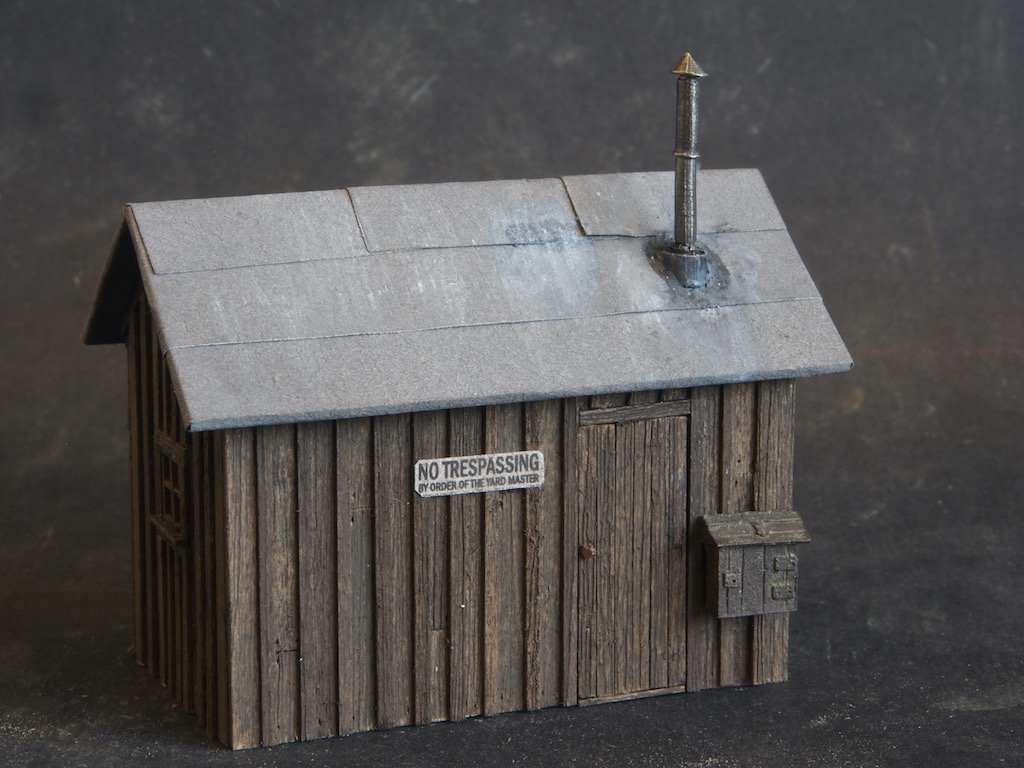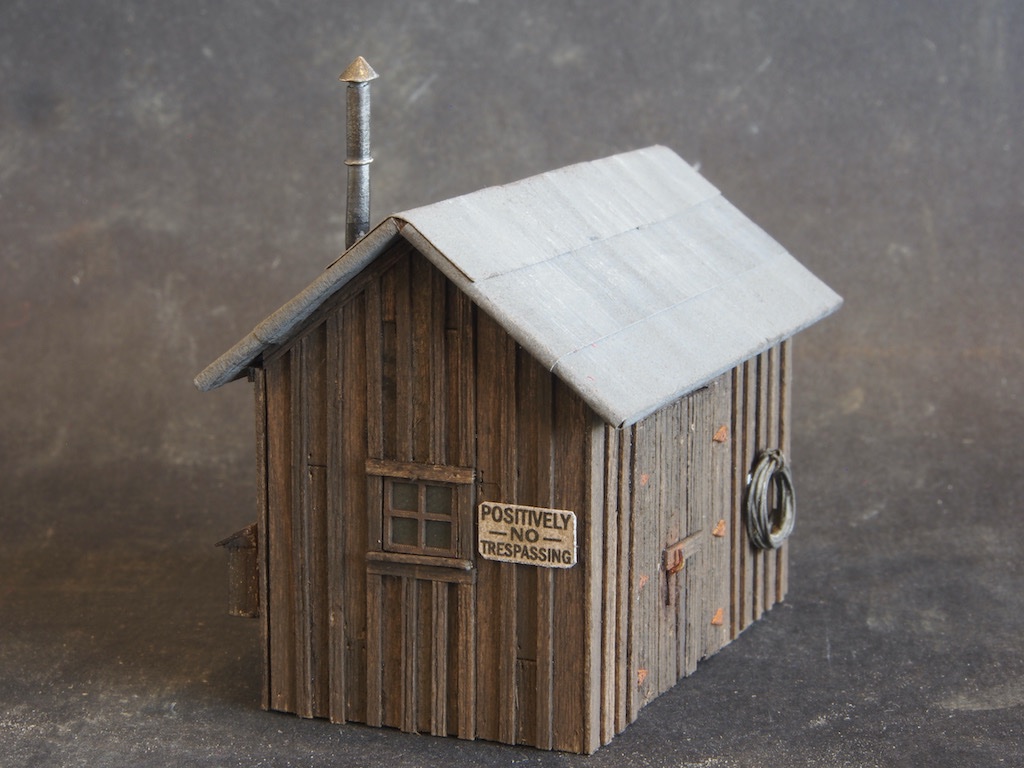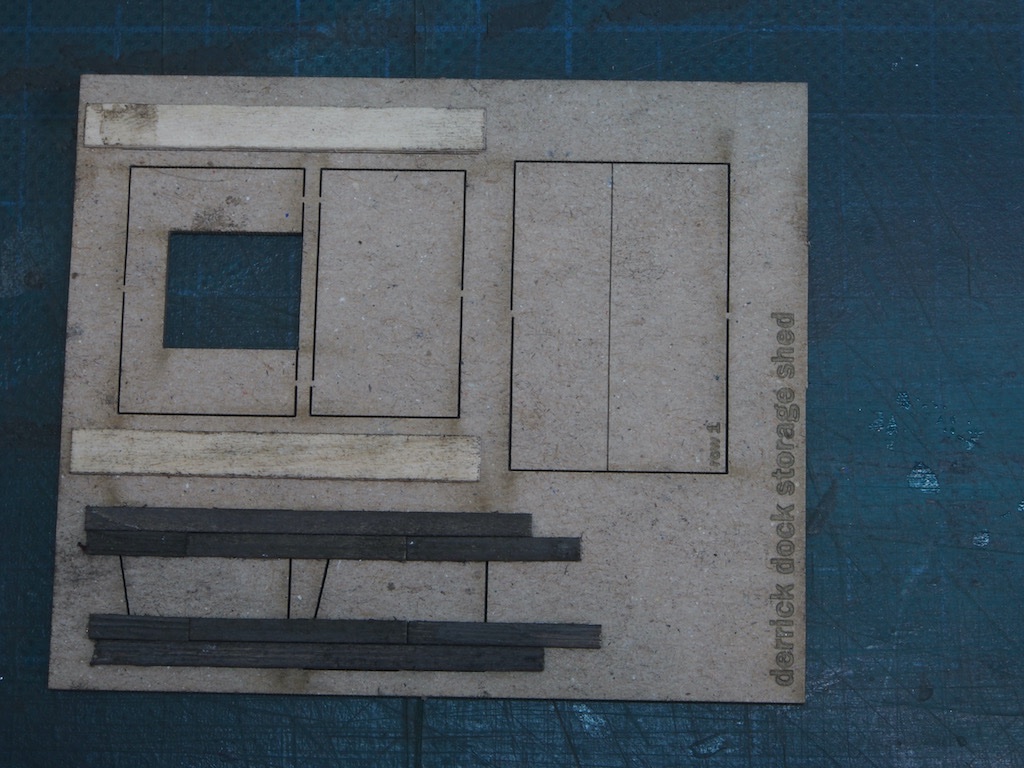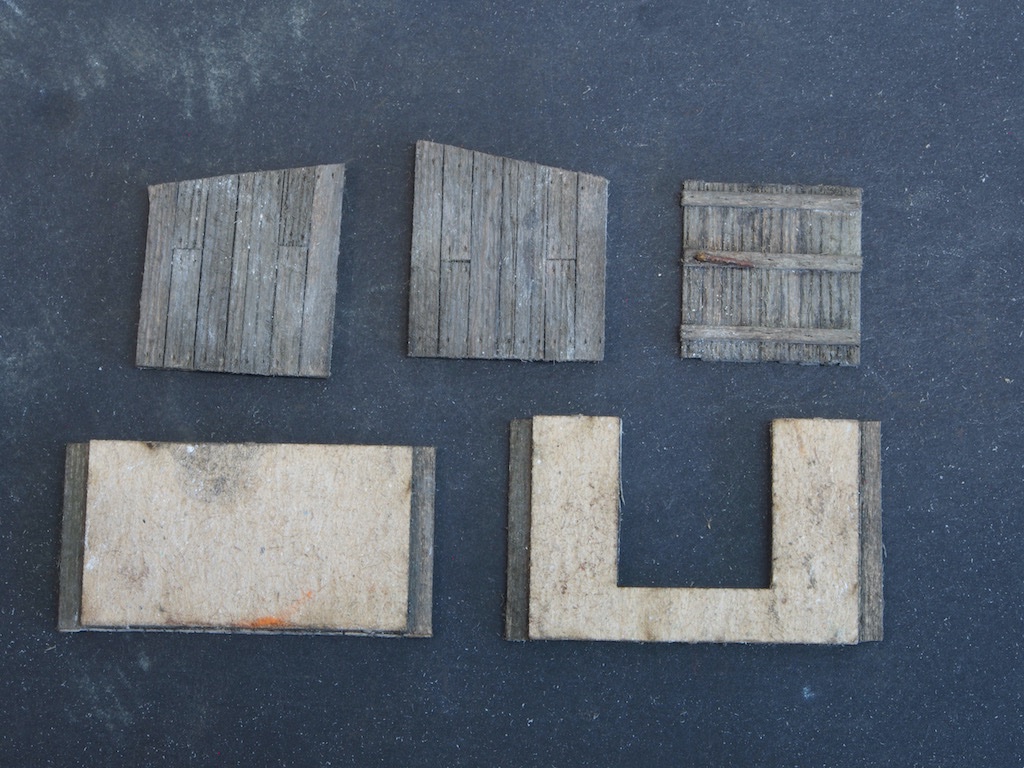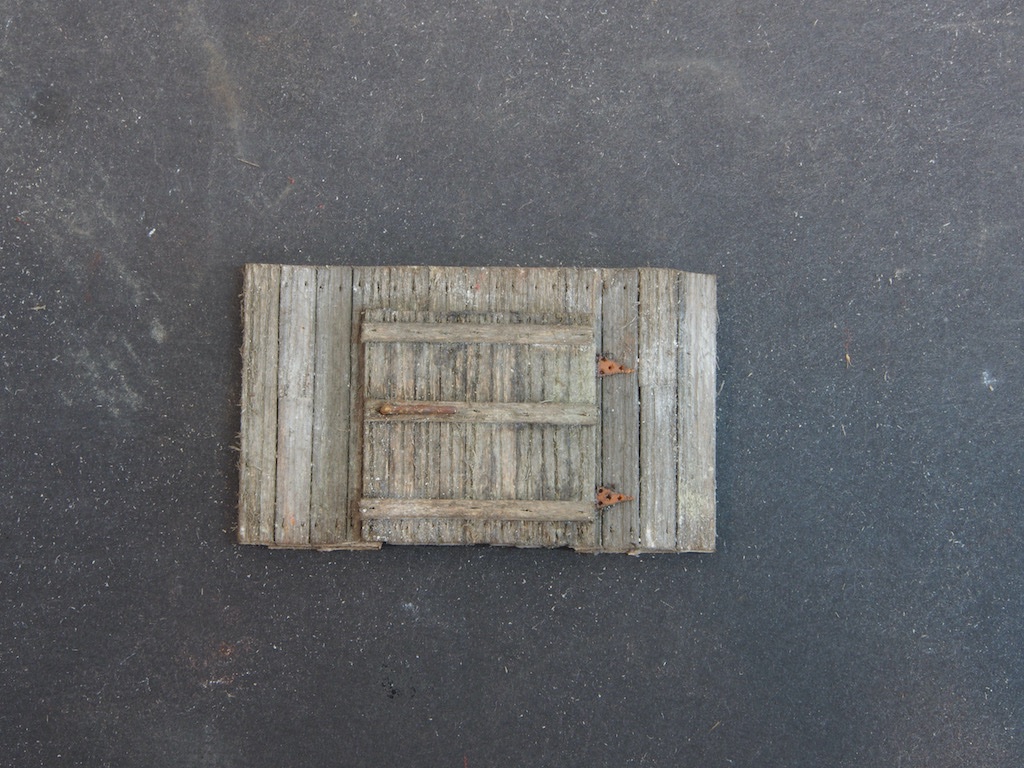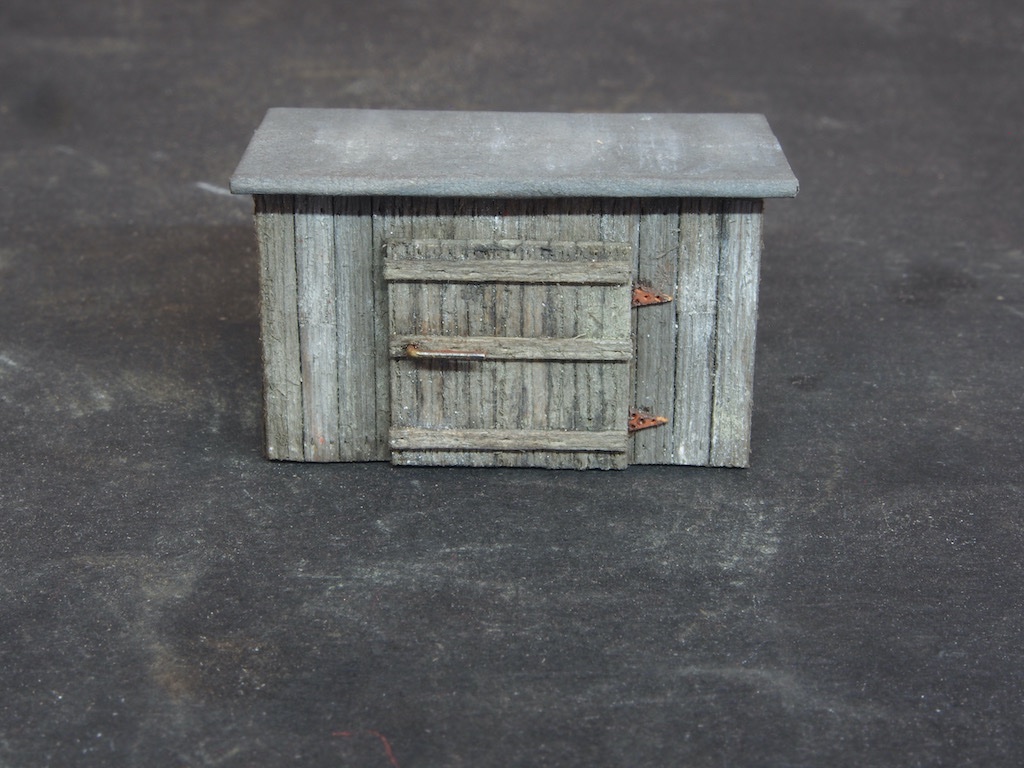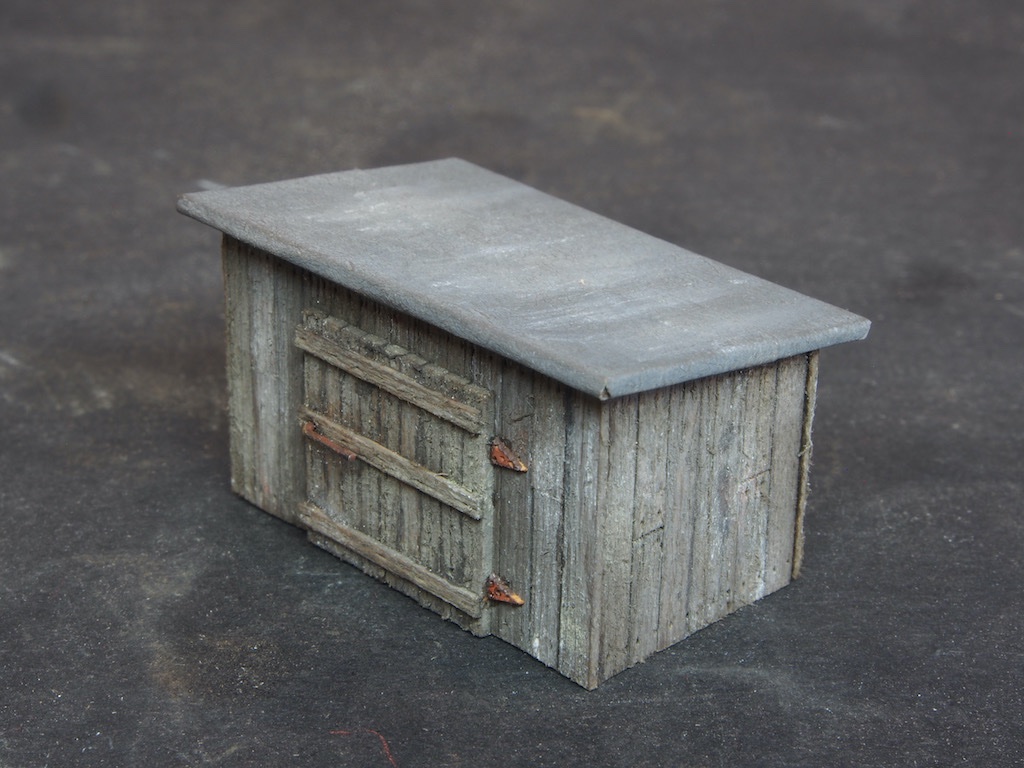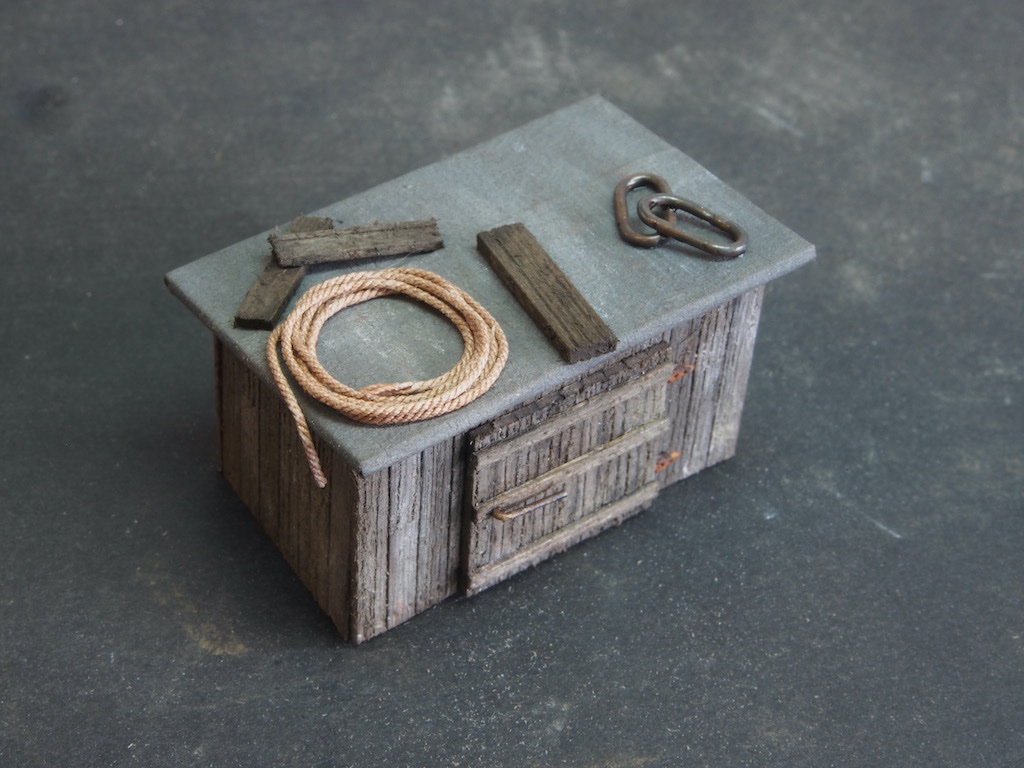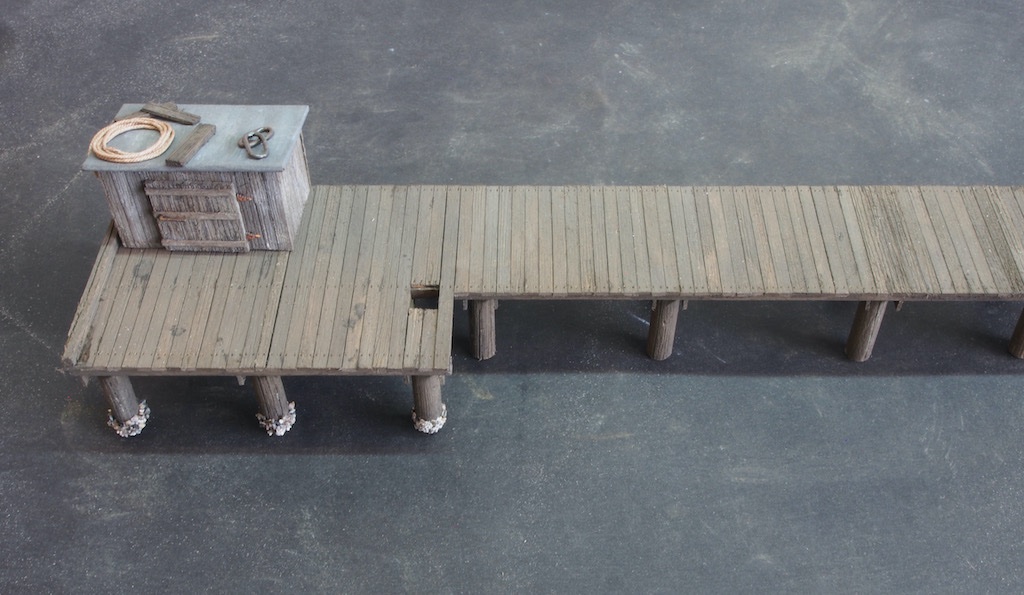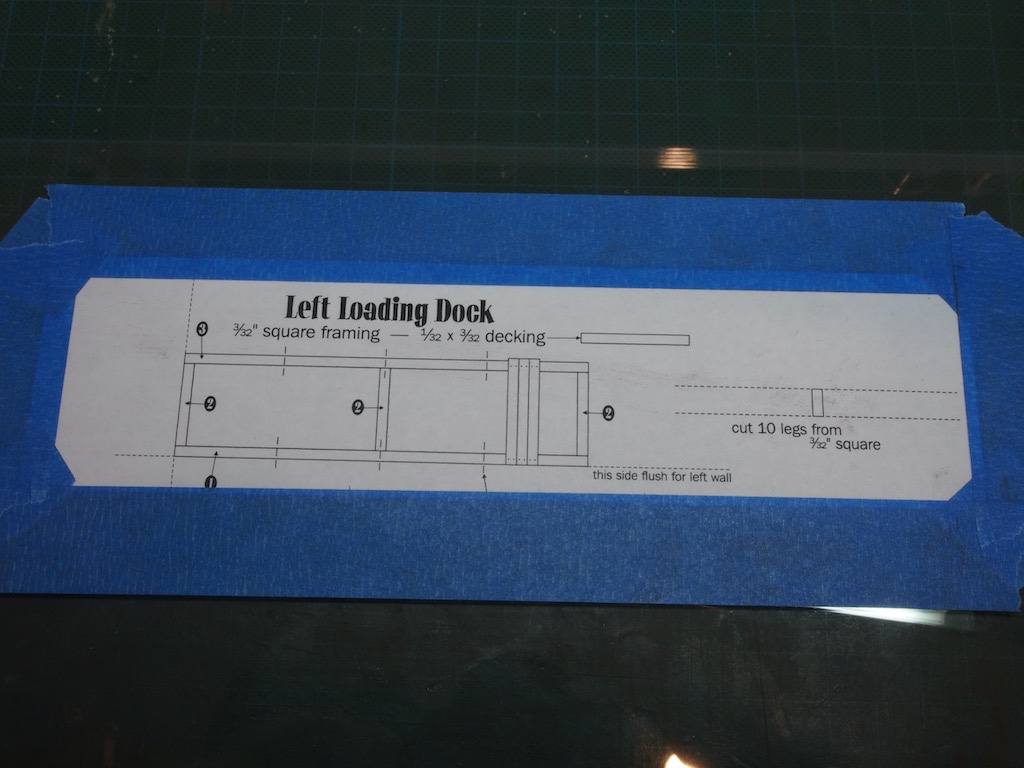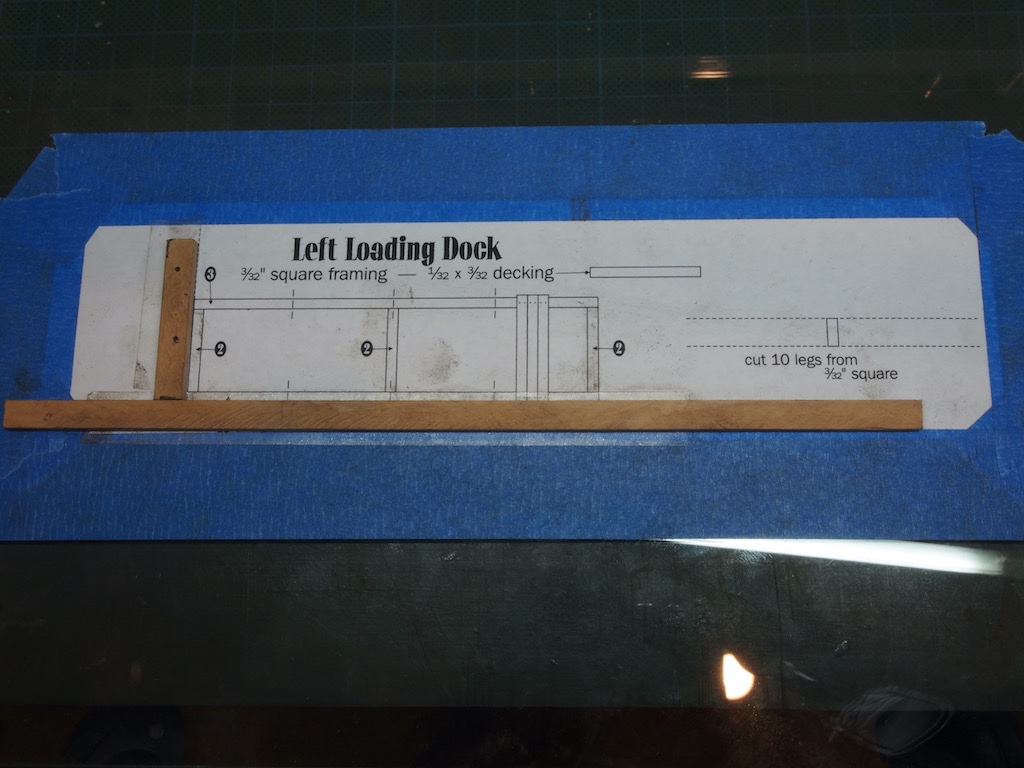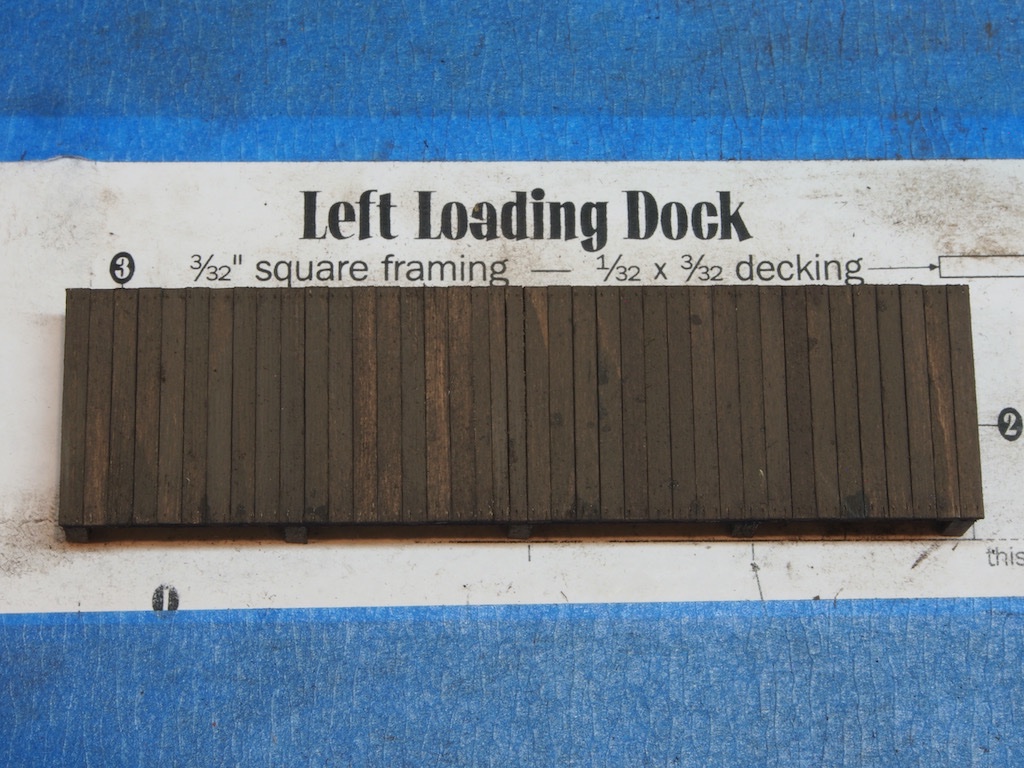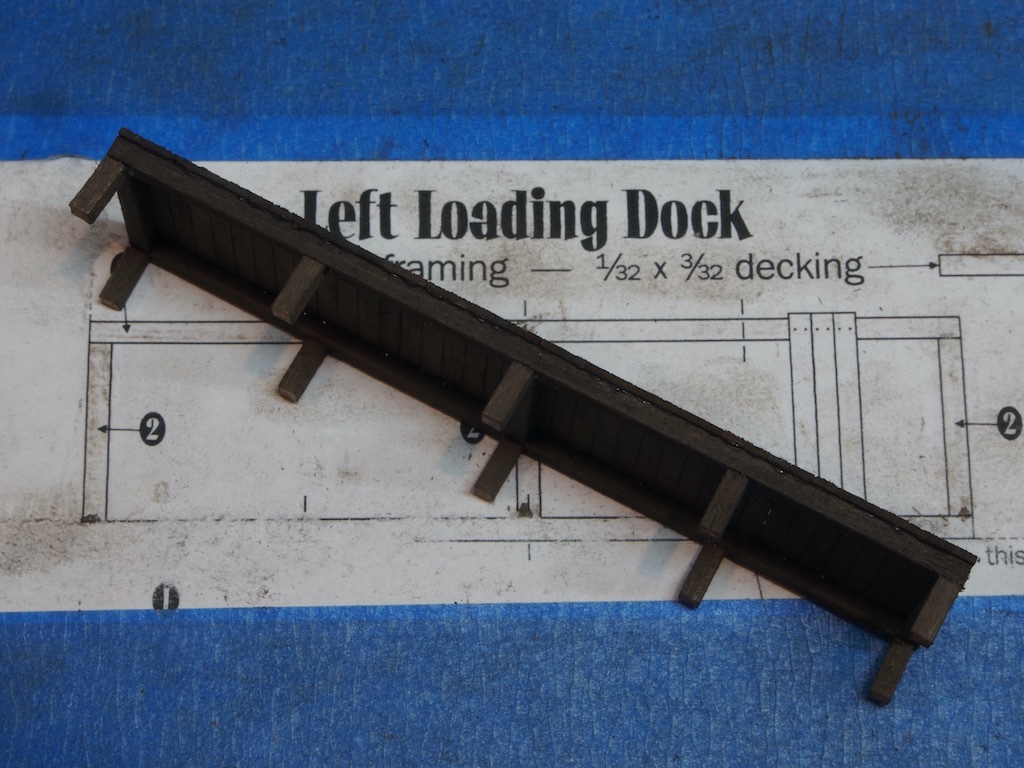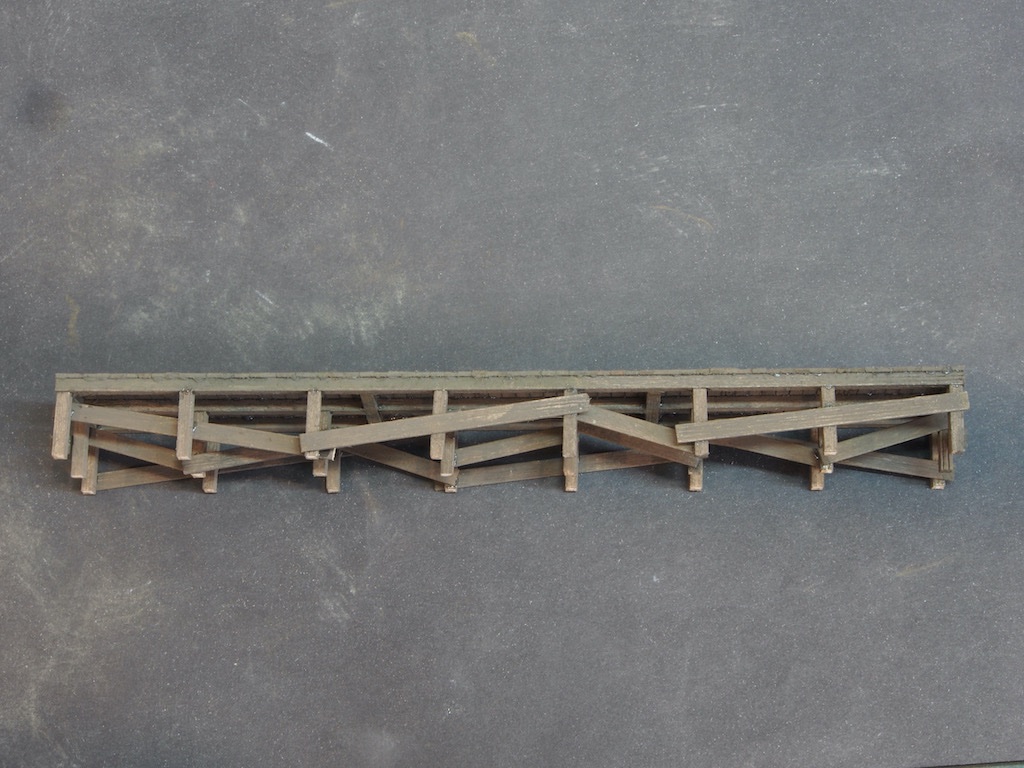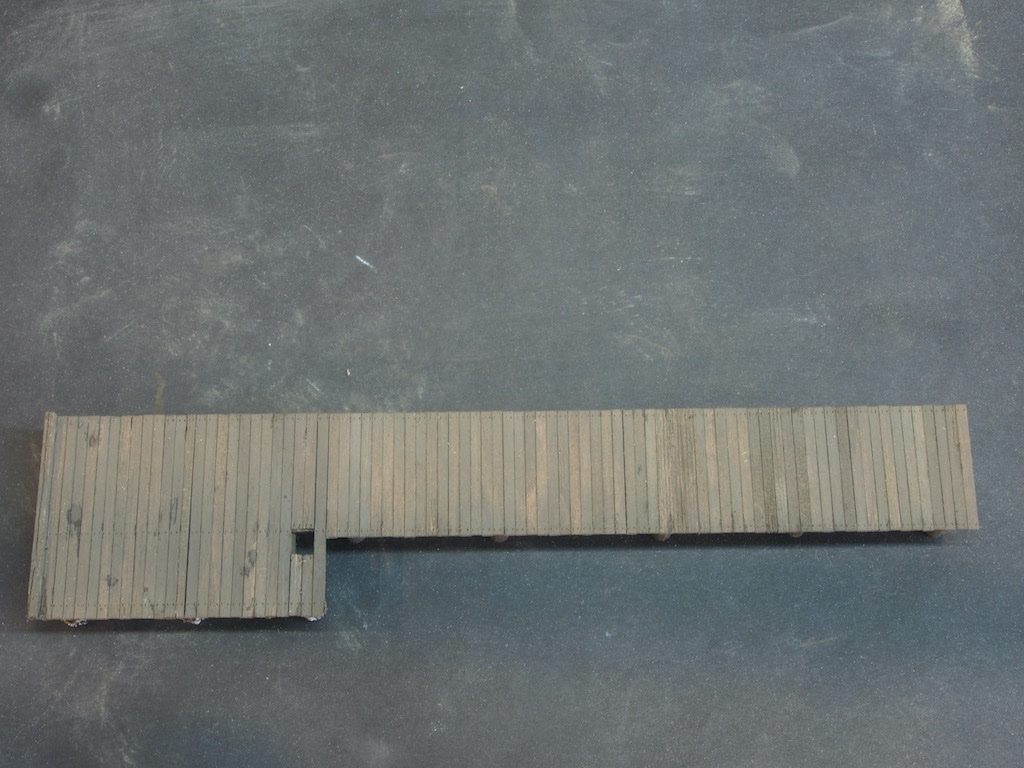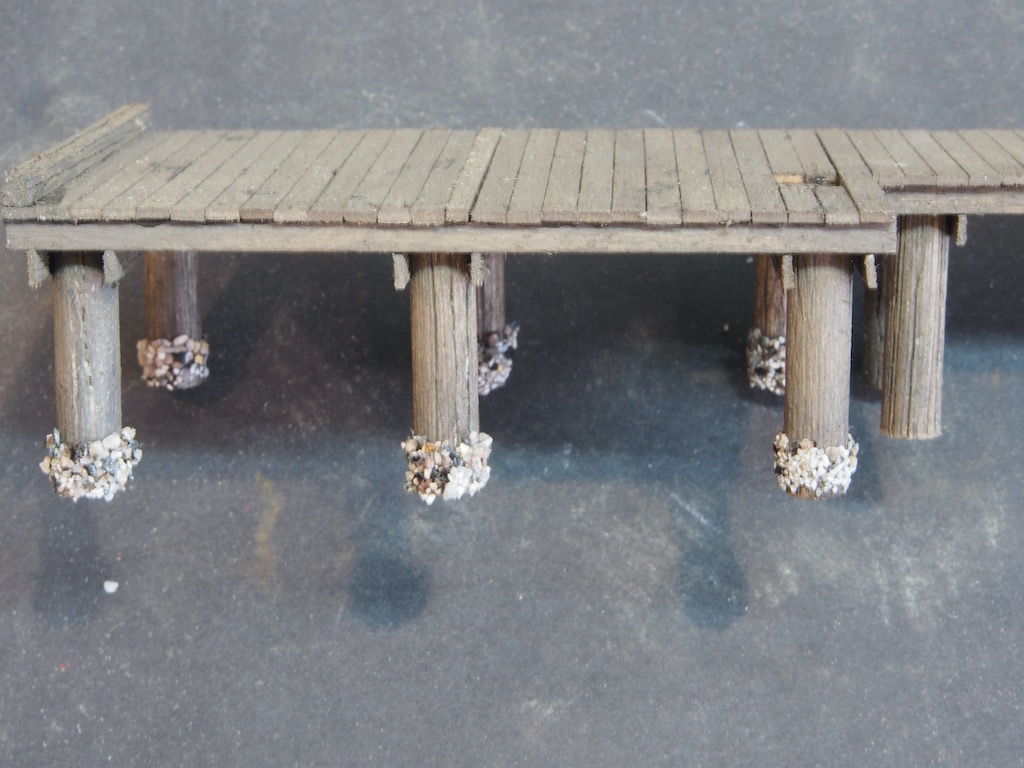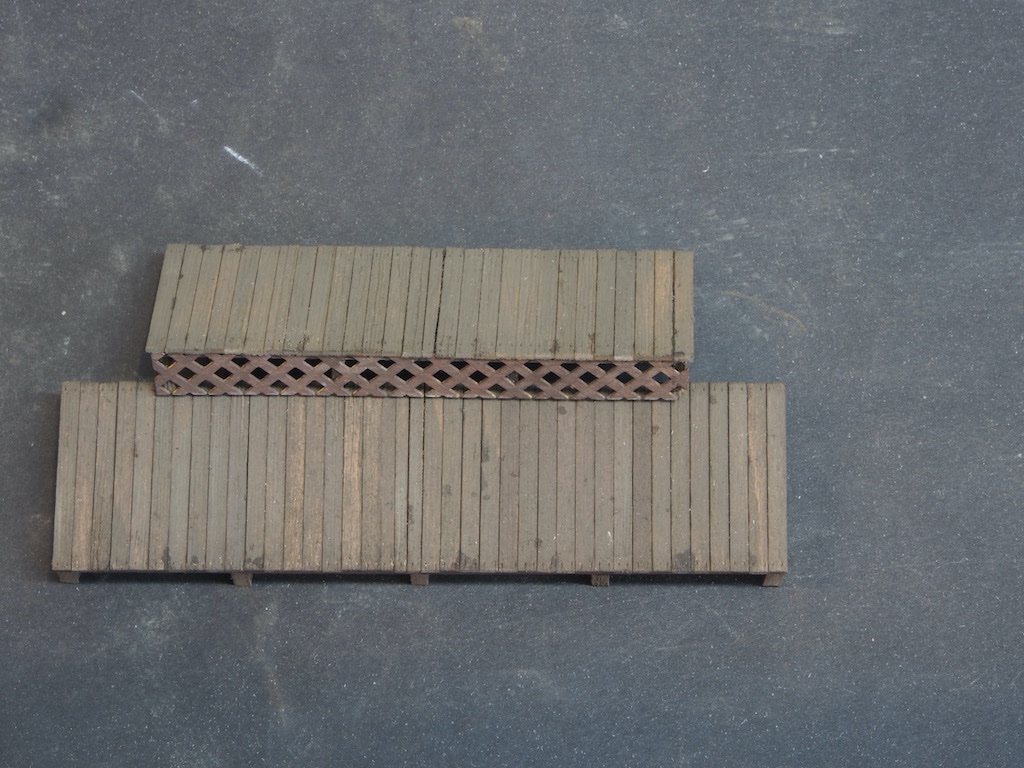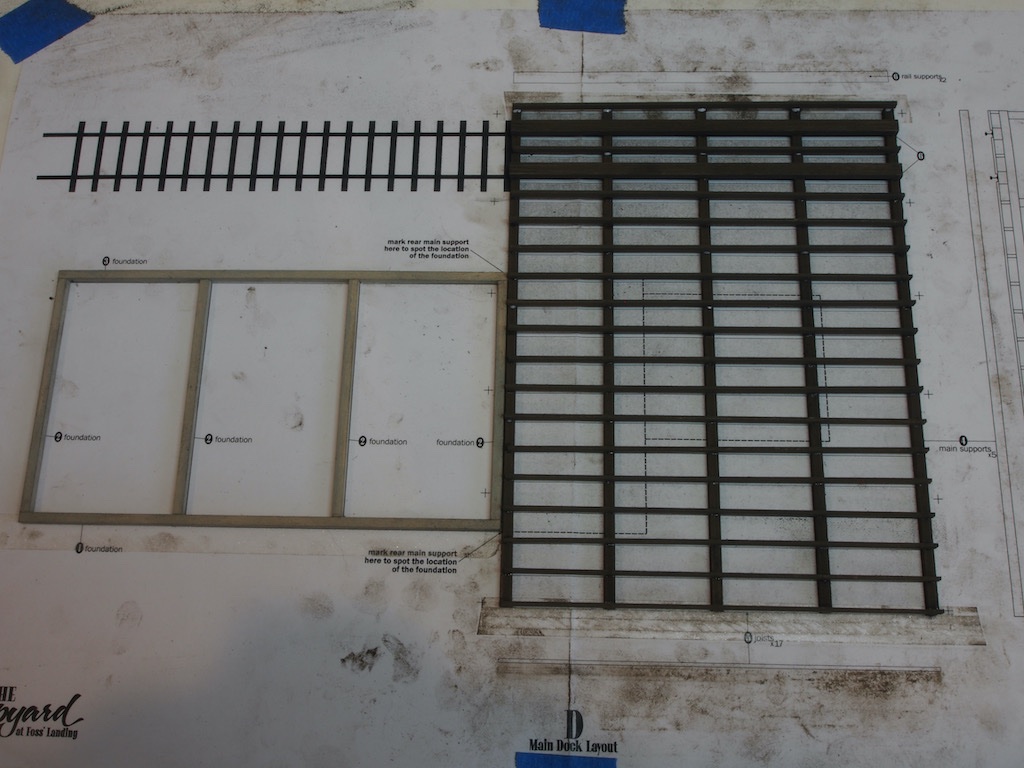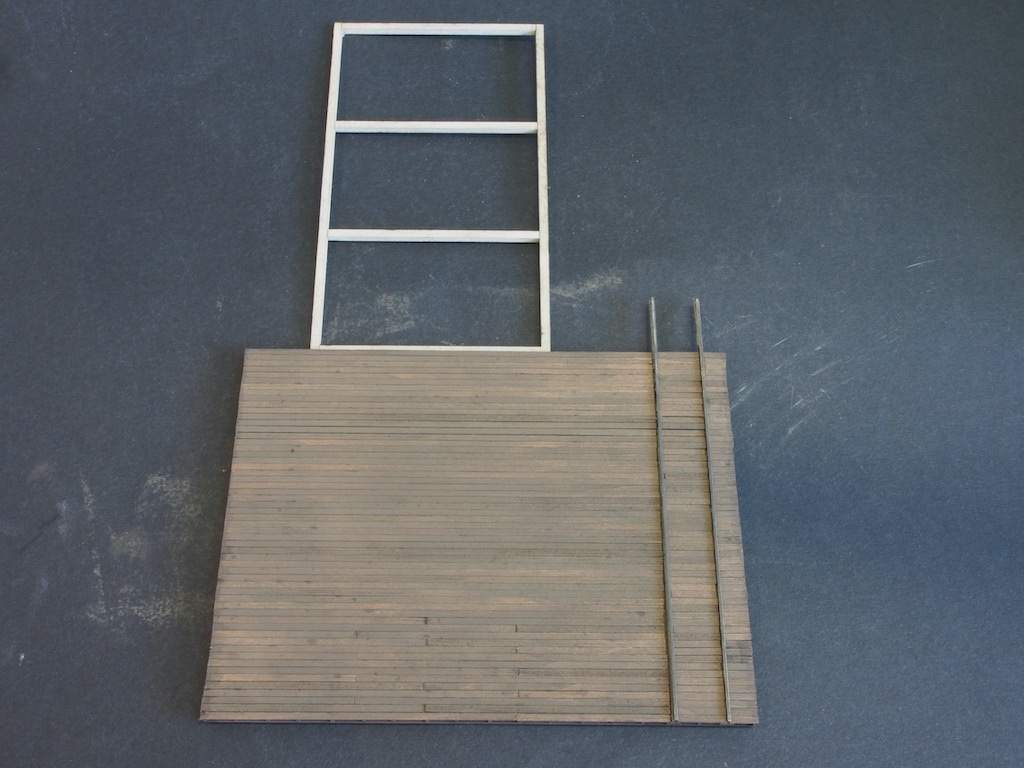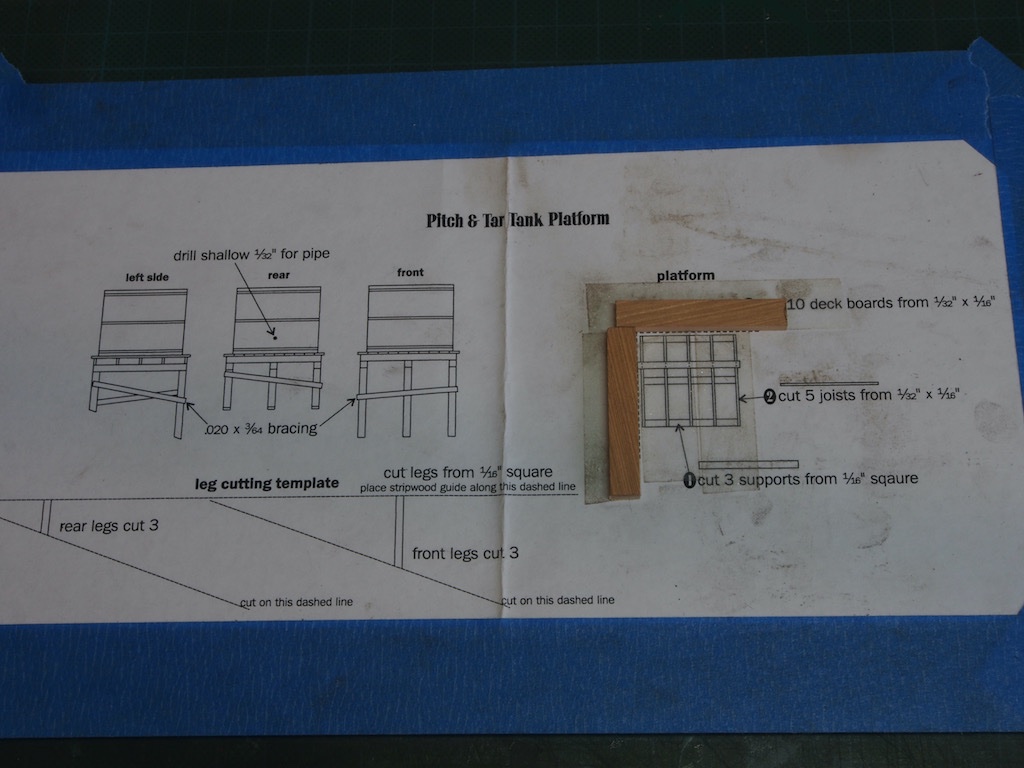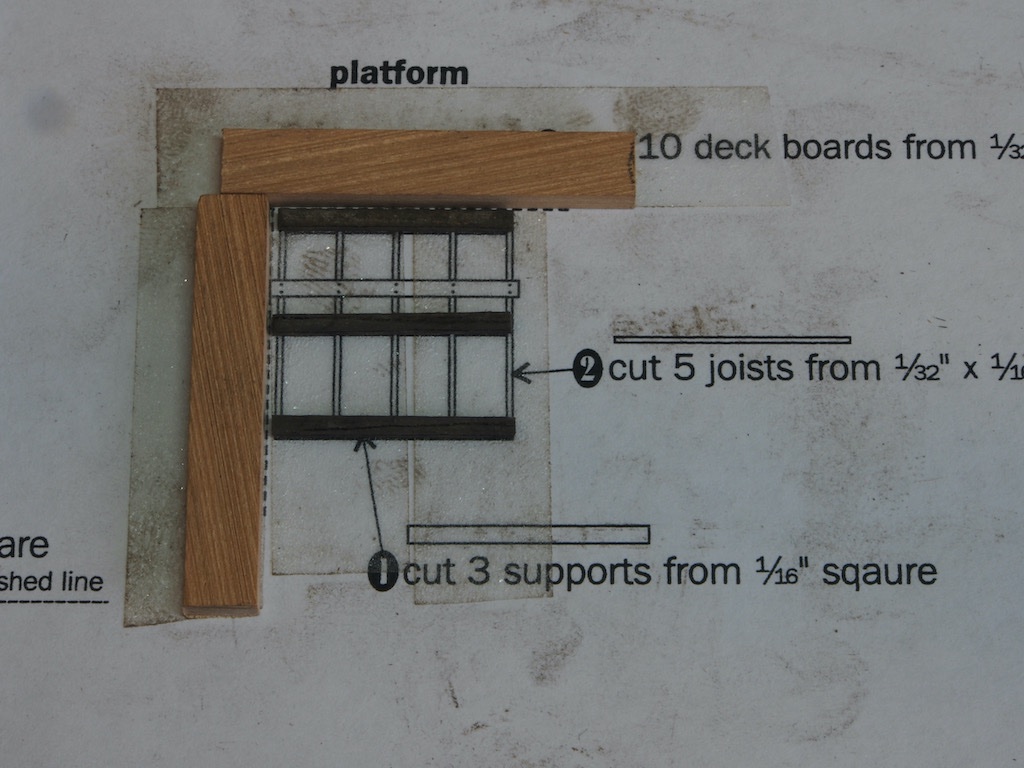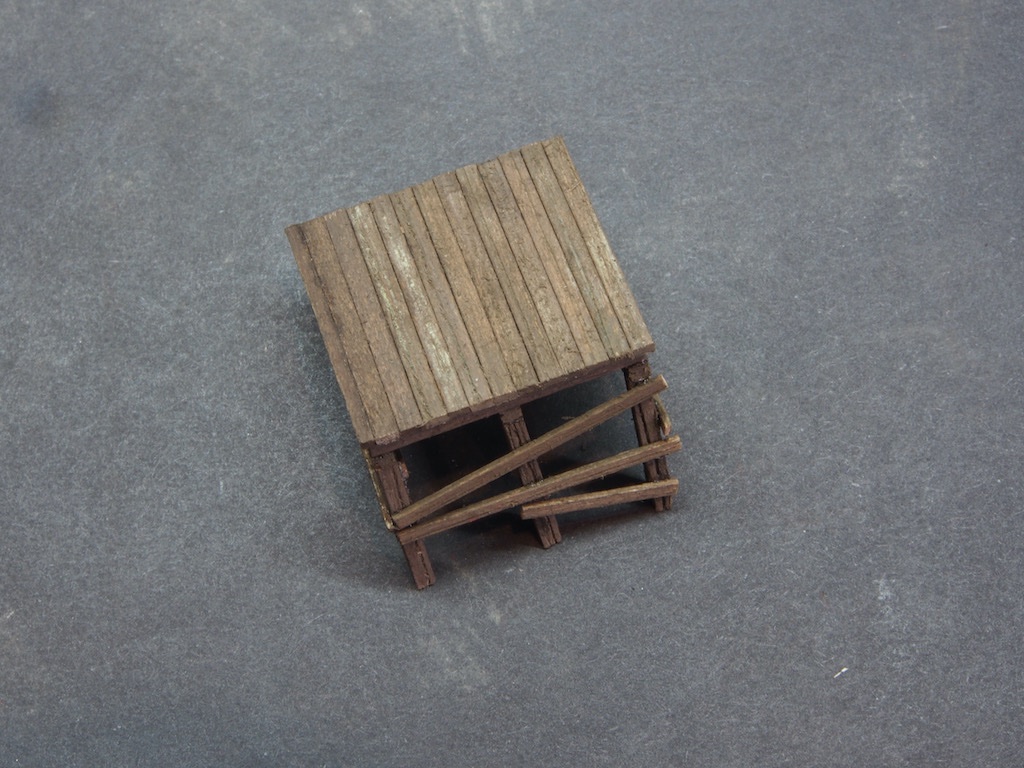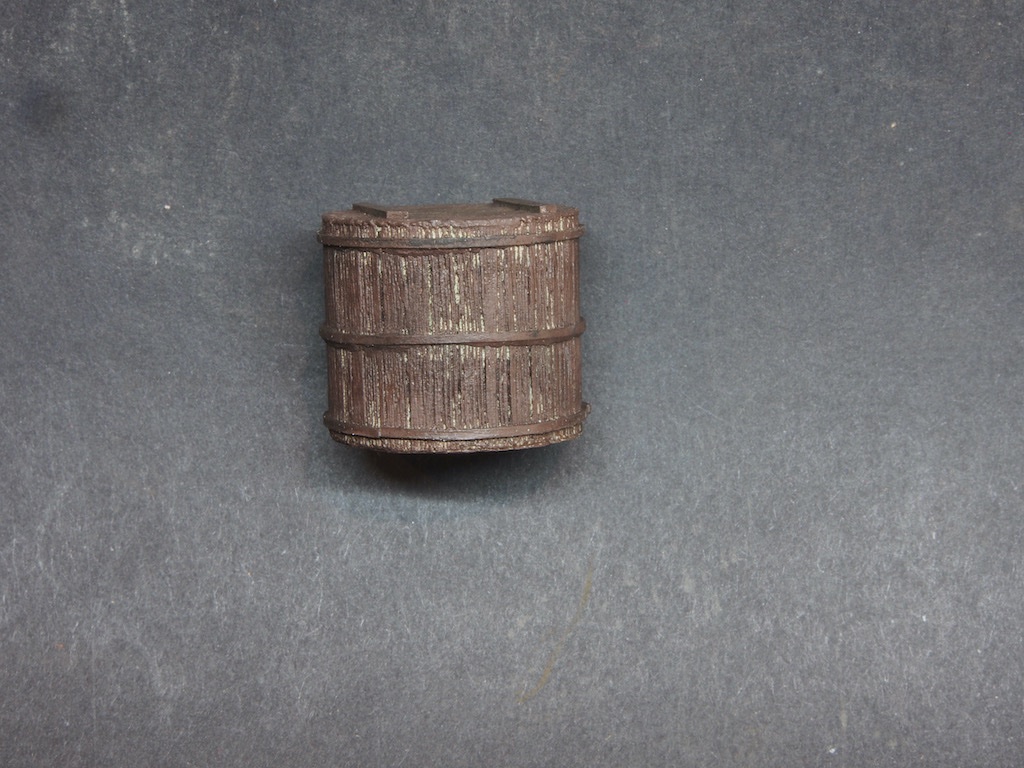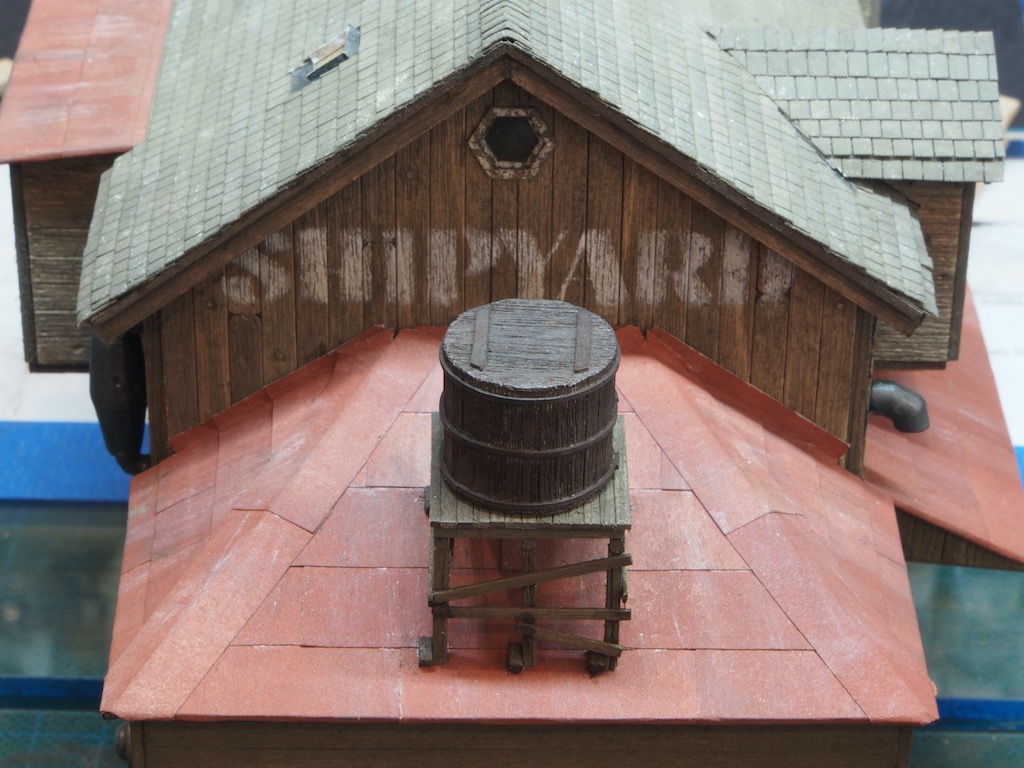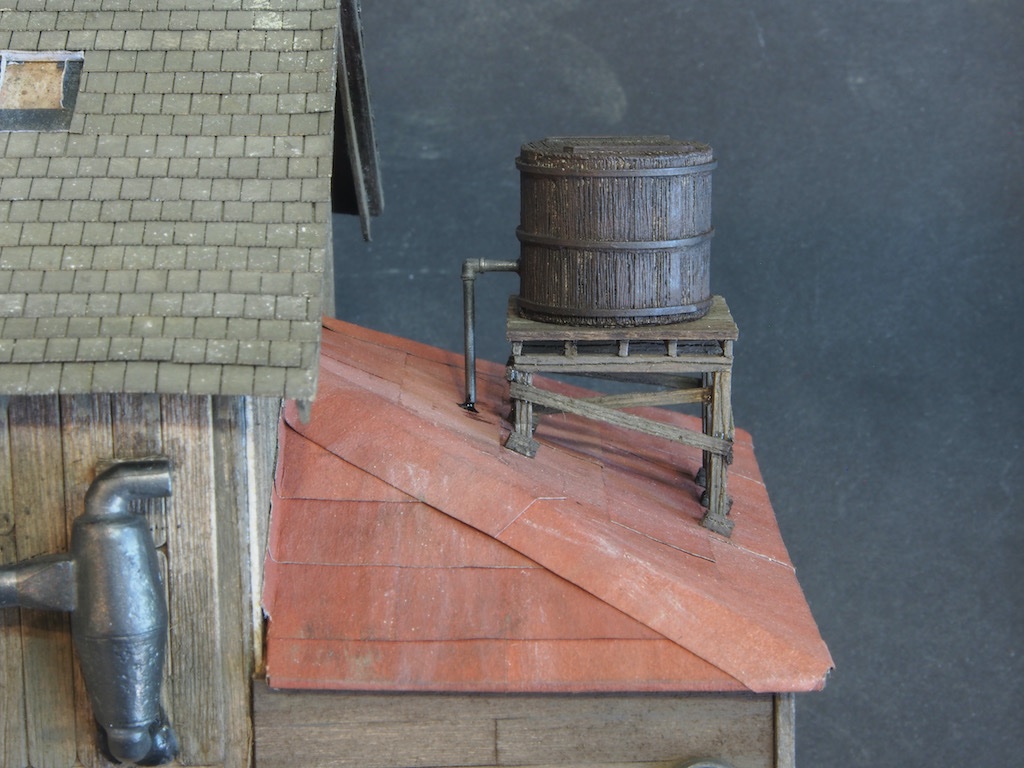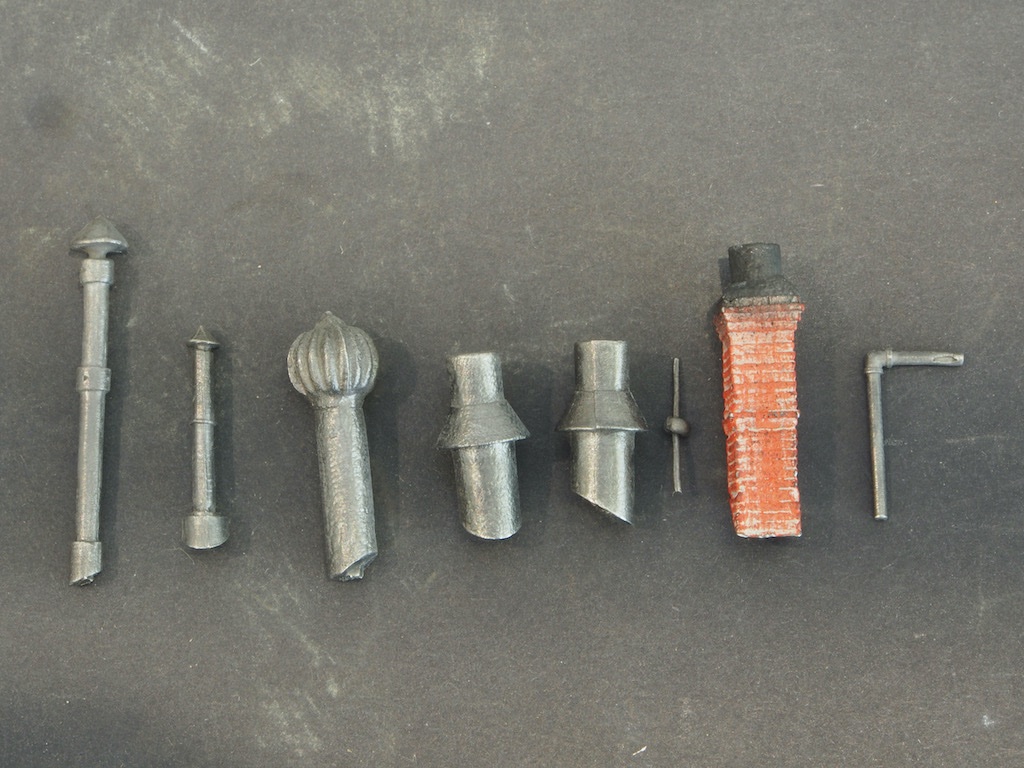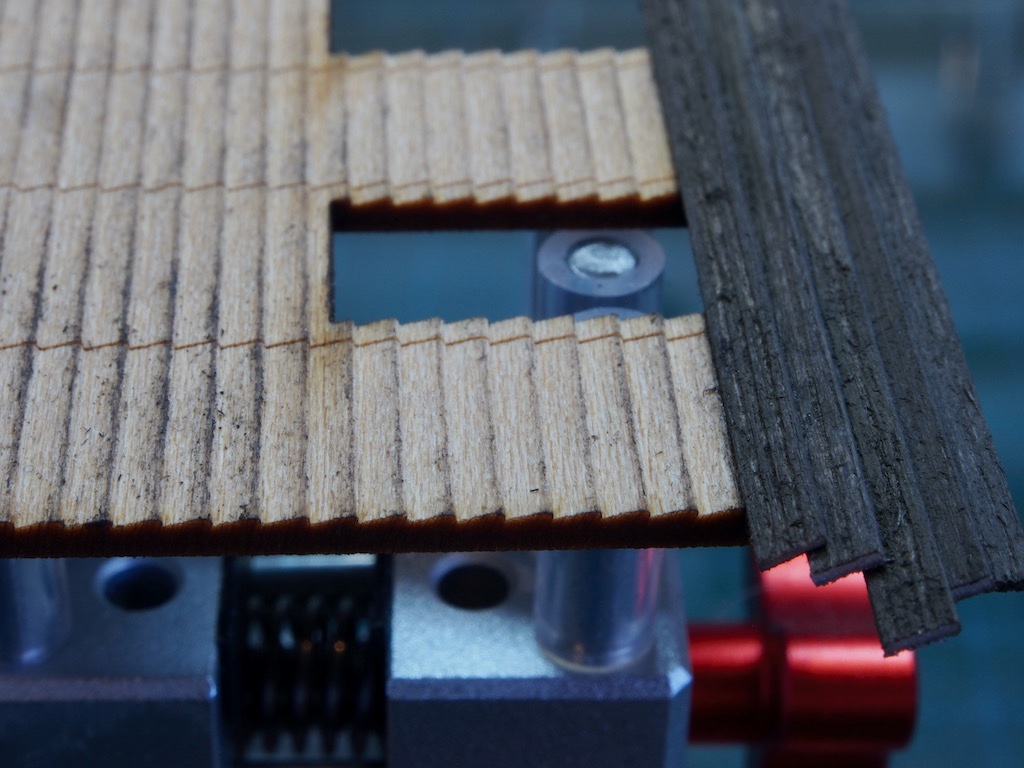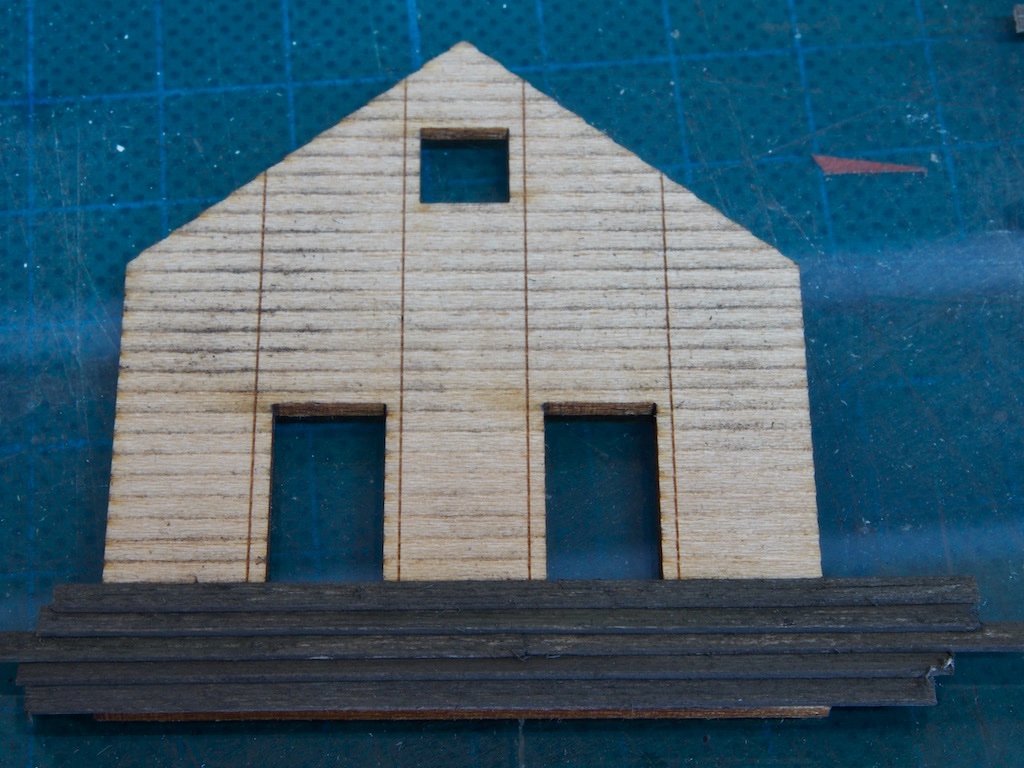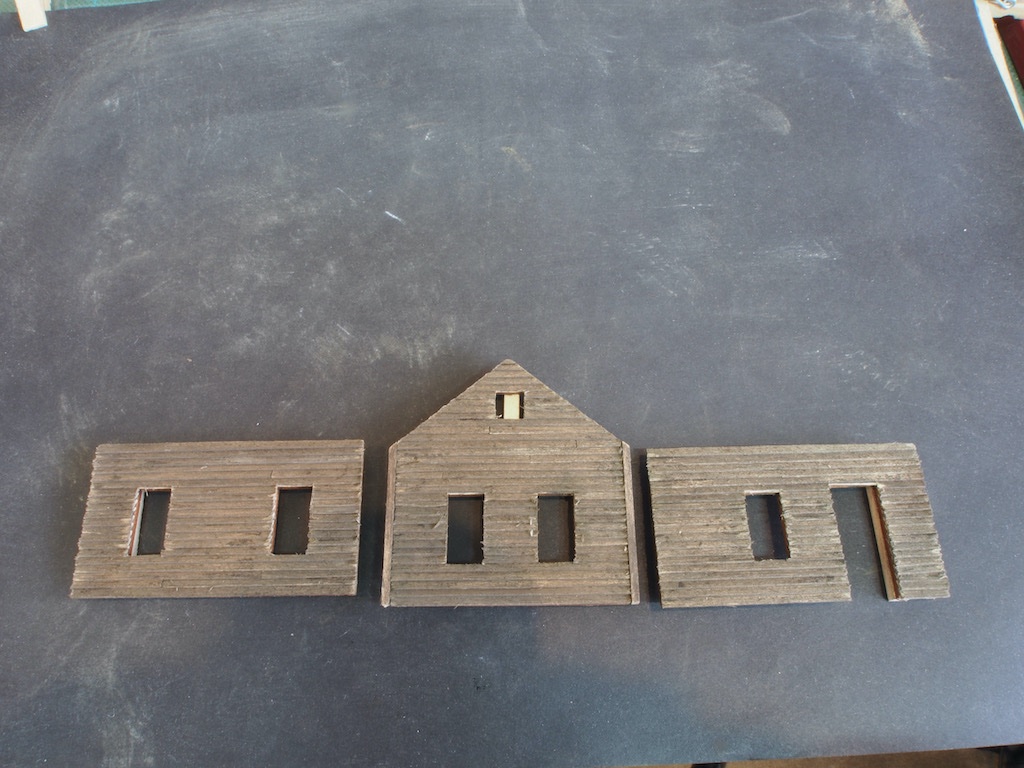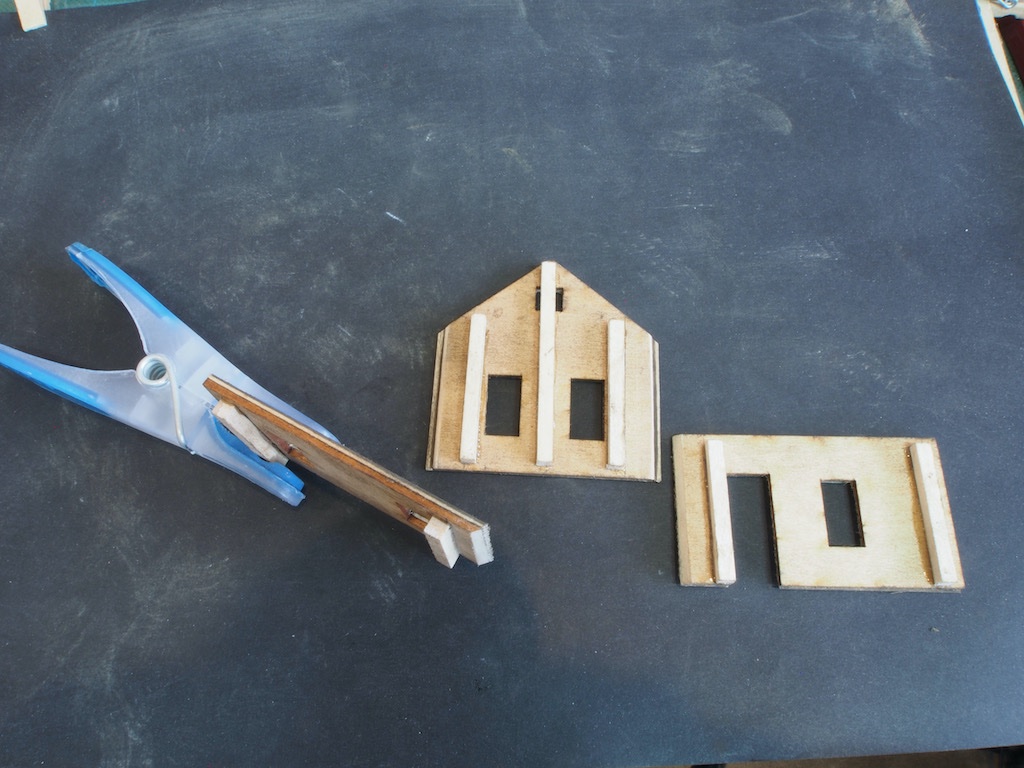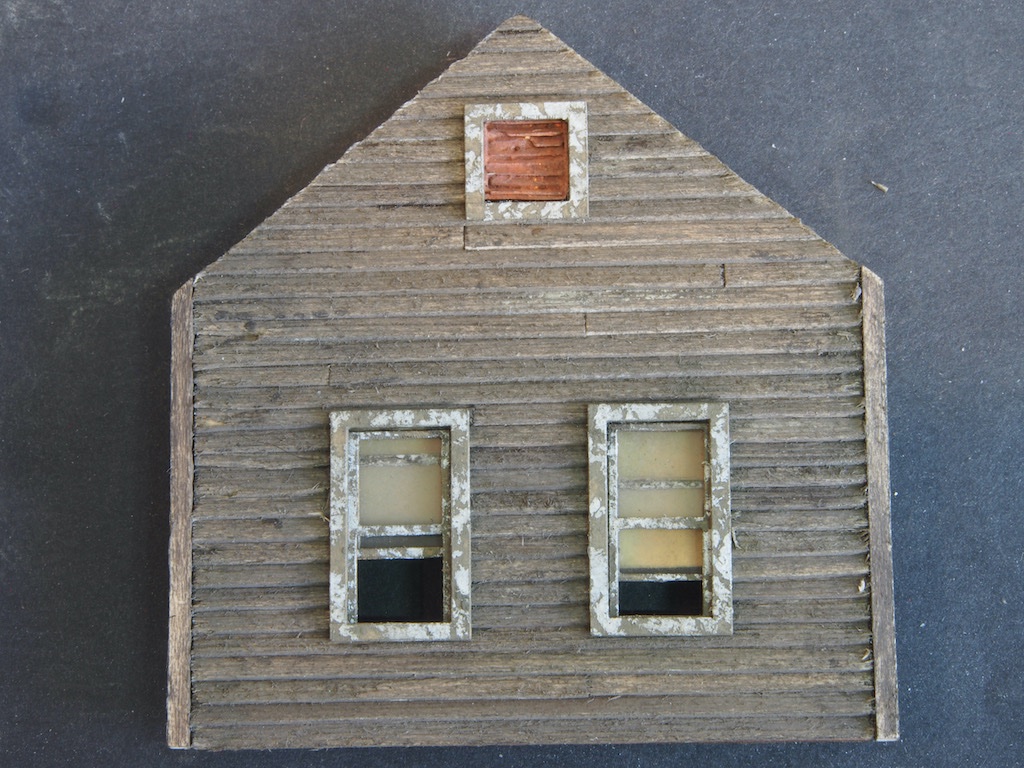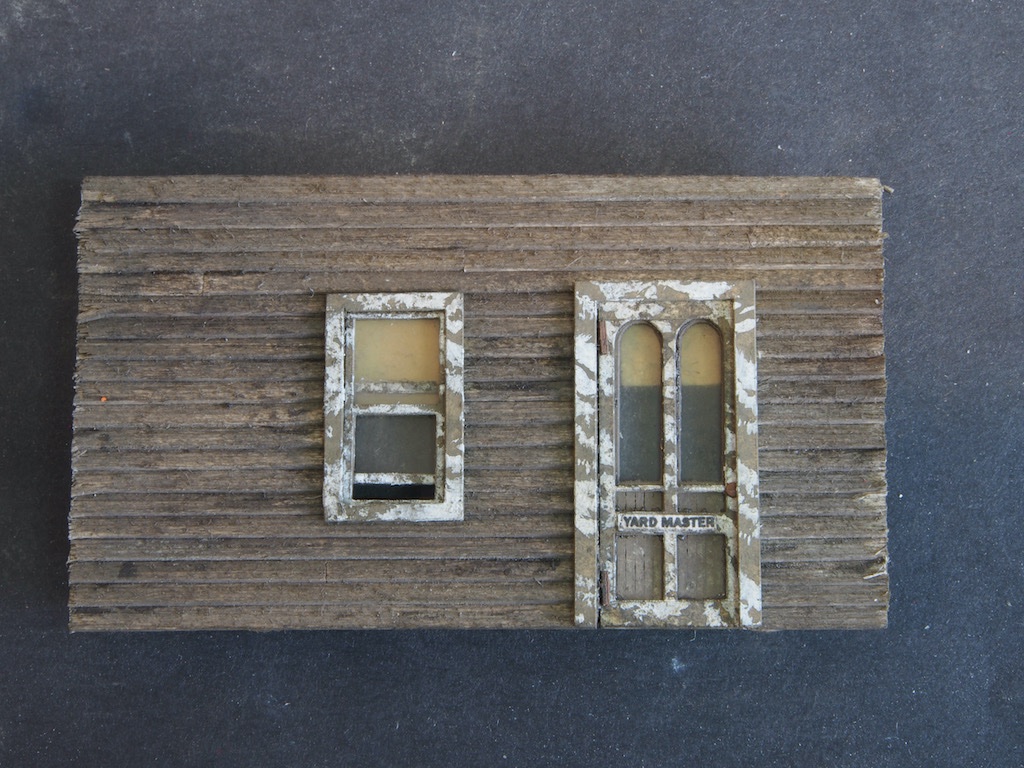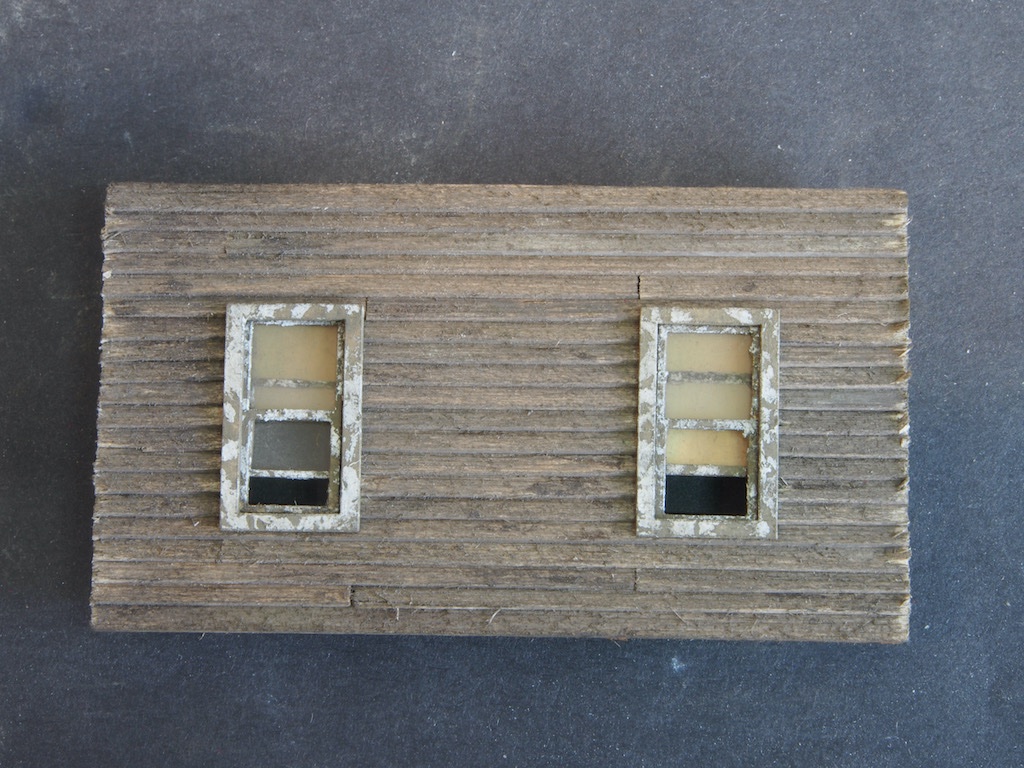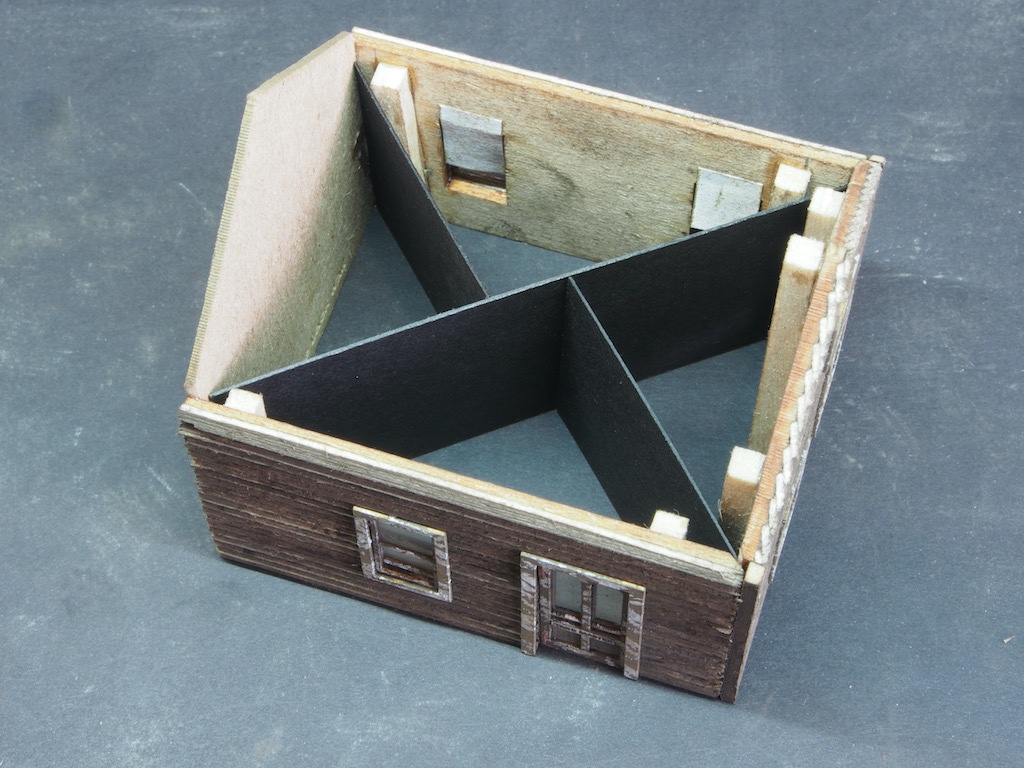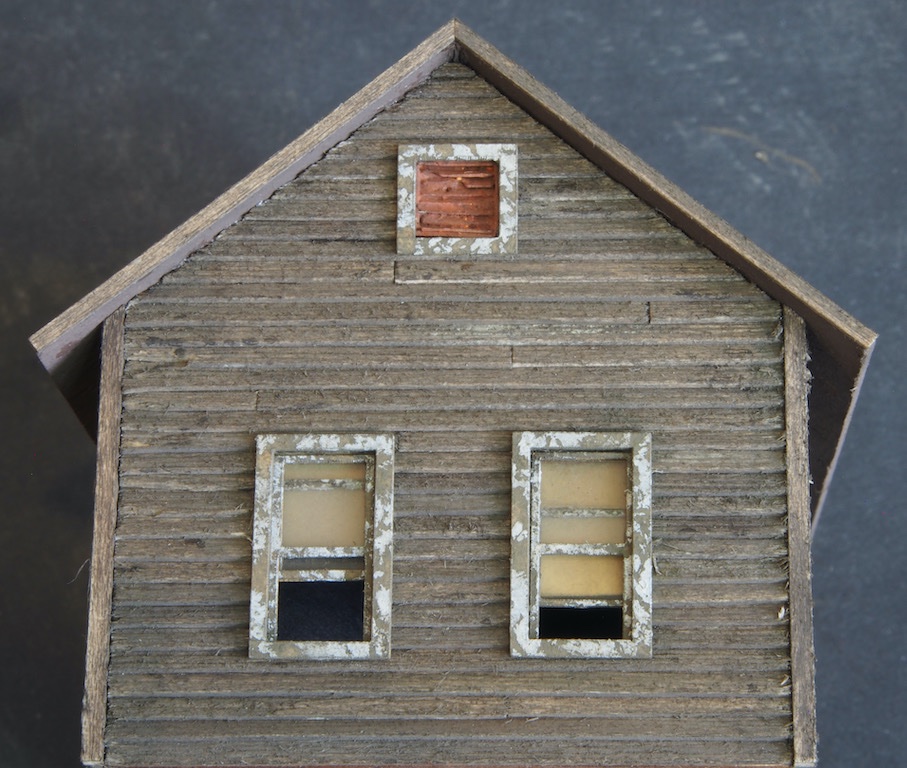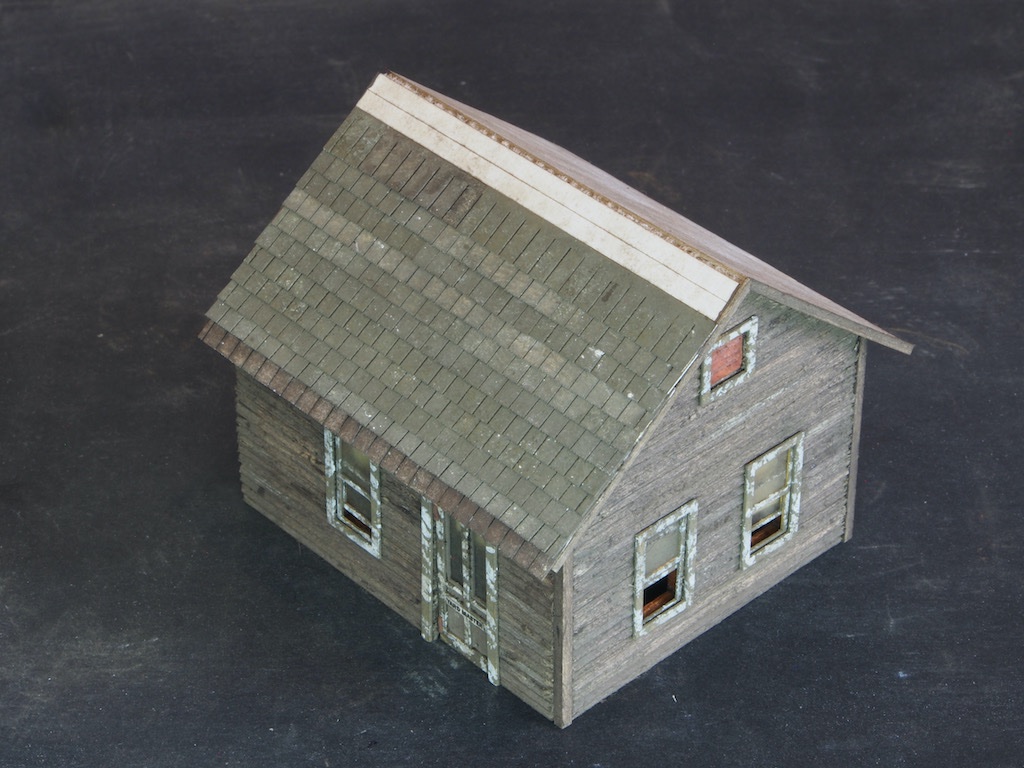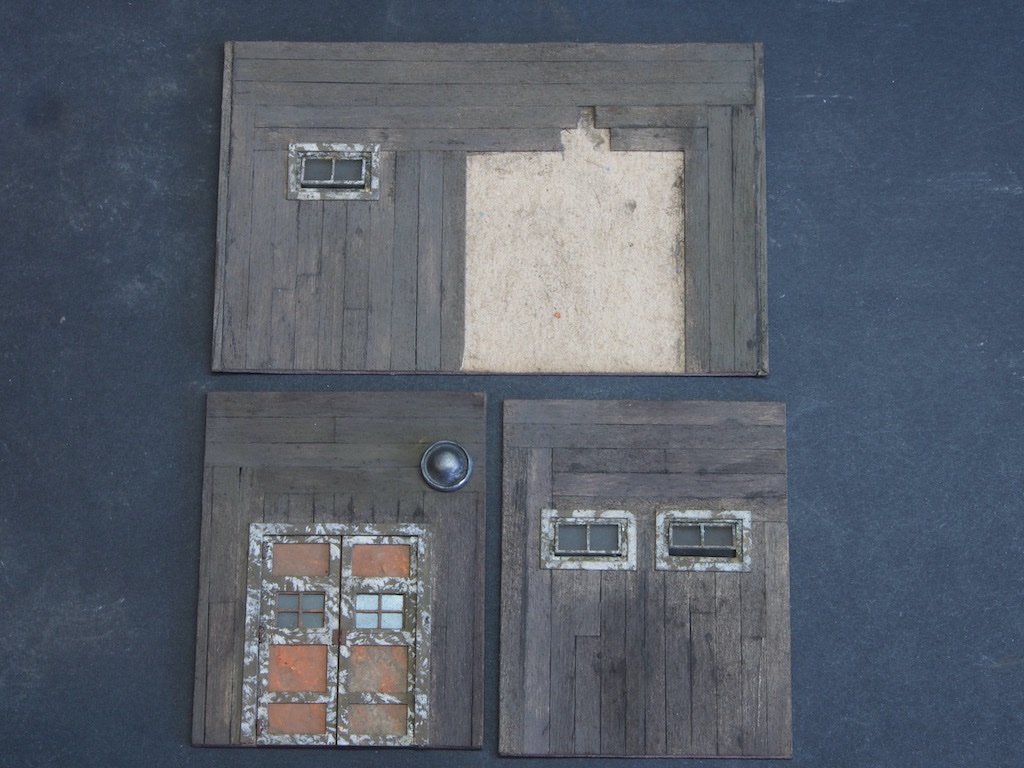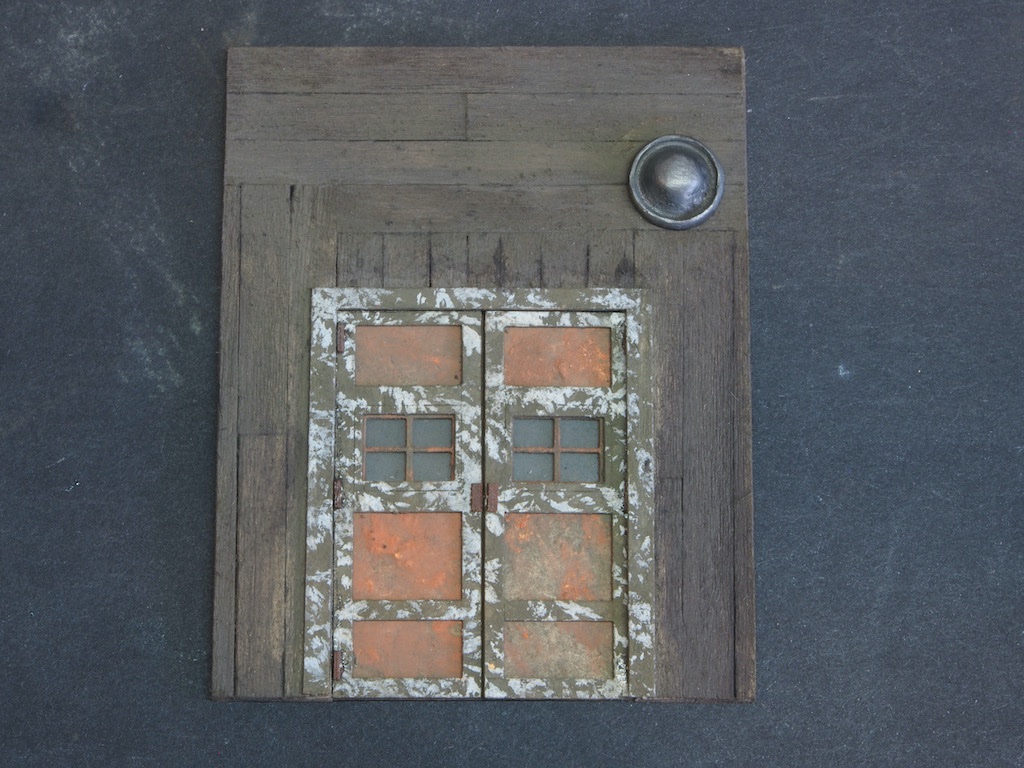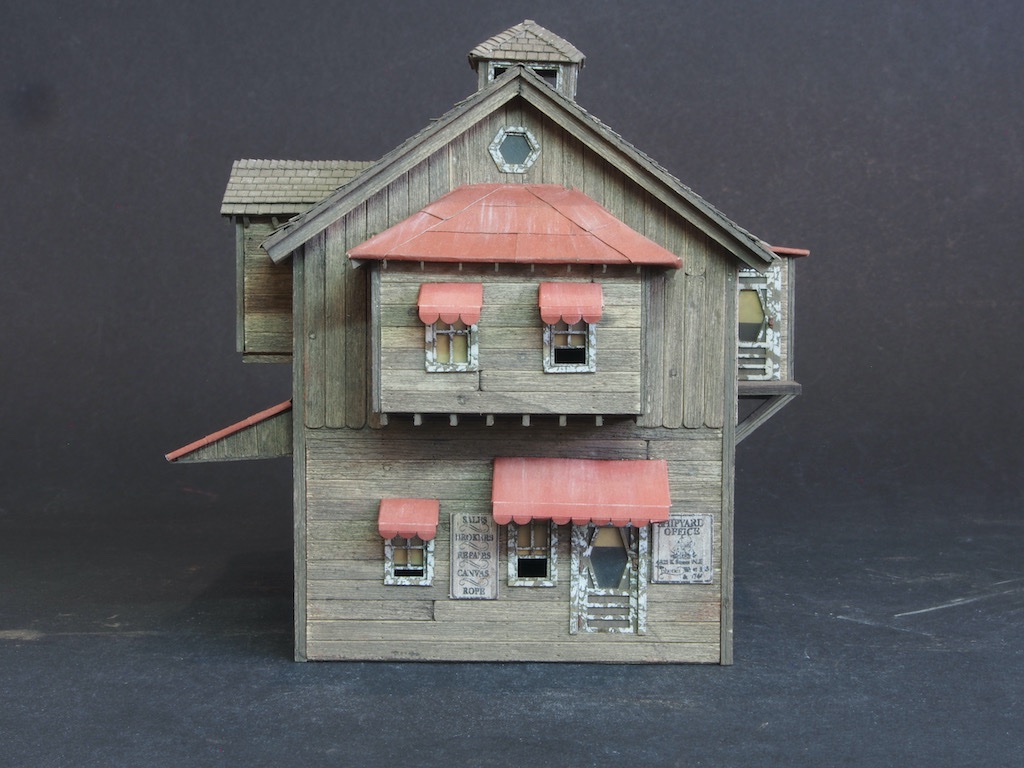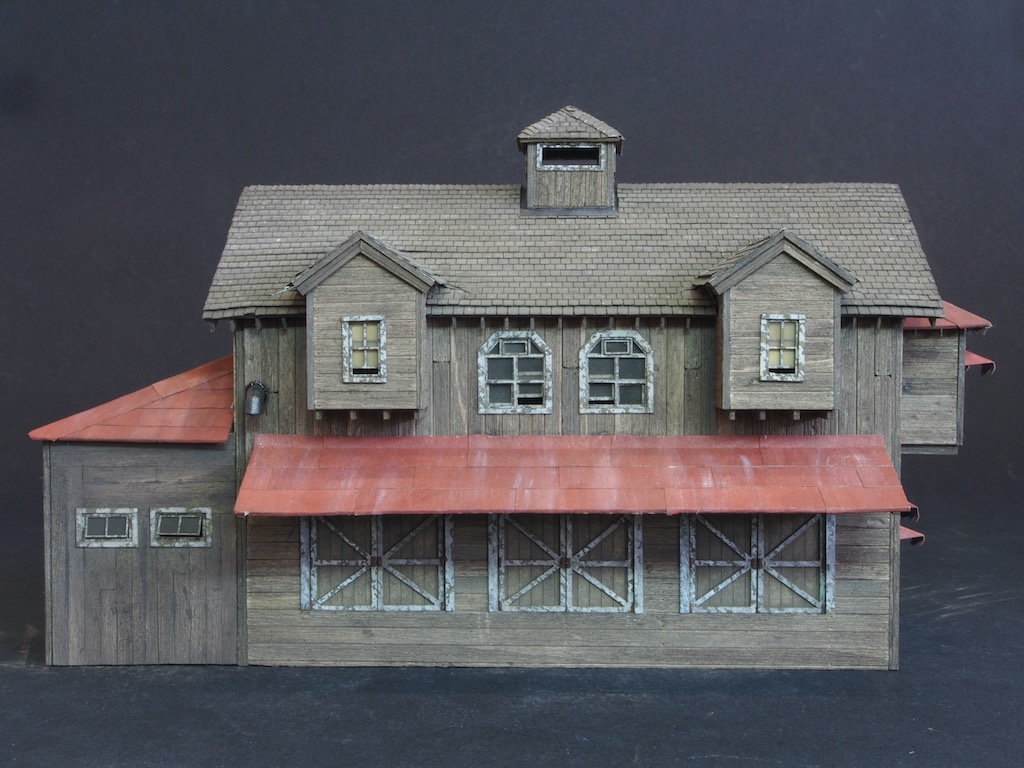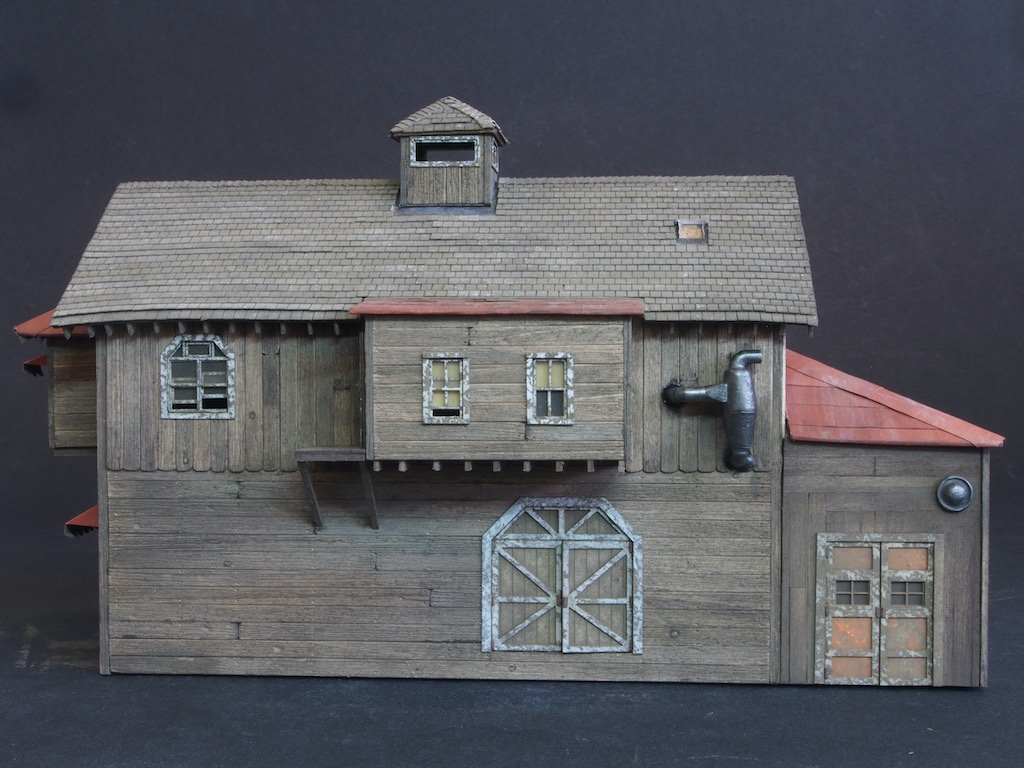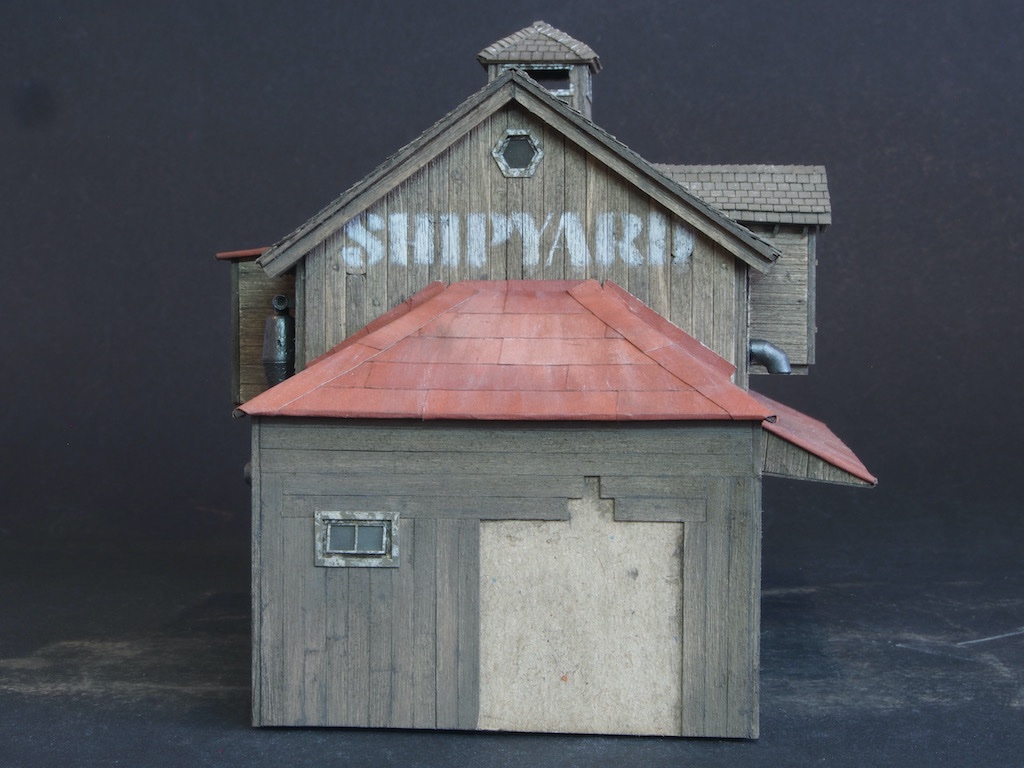-
Posts
4,888 -
Joined
-
Last visited
Content Type
Profiles
Forums
Gallery
Events
Everything posted by gjdale
-
The Saw Shed The Saw Shed is quite a complex build and is very delicate. Ultimately, it will include a great deal of detail – but that’s a little way off just yet… We start with a template upon which we build two identical walls. As this is a destructive process for the template, I scanned and printed two copies so that I could build the two walls simultaneously. As can be seen from the dimensions on the template, the framework is built up from 3/64” (1.2mm) square stock. We start by using some double-sided tape to stick down a scrap-wood straight edge and the four upright posts. Then we add the header and the braces (the braces are 0.020” x 5/64”). A cutting guide for the braces can be seen at the top right the template drawing. The wall is then removed from the template, a floor joist positioned on a fresh version of the template and the wall is glued on top of the floor joist. Cross members are then added to one of the walls, inverted (ie we’re adding the top cross braces). A tricky business to be sure. The second wall is then attached – even trickier…. And the bottom cross braces installed on top of the floor joists (since the walls are inverted, these will be below the floor joists once the walls are turned right way up). The assembly is then turned right way up and the remaining floor joists are added. Decking is then added on top of the floor joists – a relatively simple, though still delicate task. I worked from each end to meet in the middle and cut the last few boards to fill the gap. I have deliberately allowed a few gaps to appear in the decking. Next, we are provided with a cutting and assembly jig for making the roof trusses – a clever and convenient inclusion. A couple of scrap-wood guides are tack glued along the laser scribed lines to ensure that both the lower cross brace and the top brace are positioned exactly right. Once dry, they are removed from the jig and a second top brace is added to the opposite side. Here are the four roof trusses completed. The gap at the top is to receive a ridge beam. The roof trusses are then installed atop the cross members. The glue is still wet in this photo. Once cured, the ridge beam will be inserted. Then we start on the roof and the internal details…
-
Thanks Mark, Paul, Elmer, Alan and Ken. Ken - I’ve been thinking on this issue as I’ve got a few more stacks to put on the other buildings. I like your idea and had been thinking along similar lines myself. The parts don’t actually have locating pegs, so I would have to create some by drilling small holes into their bases and inserting some brass rod. Then I could do as you have suggested. It might be a little tricky to get a piece of wood into the underside of the roof, but I’m sure it can be done. I’ll have a good look at this before inserting any more stacks. Thanks for the input/suggestion. 😊
-
Congratulations Bob, I’m sure Hannah will love it - all the more by being made for her by you.
-
Thanks OC, Ron and Gary for your kind comments, and once again to all the "likes". Moving right along.... The Upper Yard Storage Shed This is another little gem of a building. Its construction starts in much the same way as the Derrick Storage shed just completed. Once the basic walls are completed, a new style of construction is introduced by the addition of thin vertical battens at the join between each plank. The effect is quite convincing. Each of the walls now gets its own level of detail. The Left Wall is left plain, with the exception of the addition of a window (not shown in this photo). The Rear Wall gets some double doors, complete with split boards, rusty hinges, and a locking bar/latch. It also gets a coil of rope that is actually a metal casting – cleaned, blackened, painted and chalked. The Front Wall gets an entry door, a mail box (a resin casting, painted and chalked), and a sign. And finally, the Right Wall gets a window and another sign. The walls are then glued together using the “trap” method as with the previous building, and a tar-paper roof. The roof also gets a stack – another casting that is cleaned, blackened, buffed, and epoxied in place. This was quite tricky to do due to the weight of the metal stack. I literally had to hold it in place until the epoxy started to set up. Here are a few shots of the completed building. That completes the Upper Yard Storage Shed. The Saw Shed is next…
-
The Derrick Dock Storage Shed This little building is a gem. It is made up by gluing strip-wood boards (prepared as per previous boards, but with a little extra greying to show a more weather-beaten look) over a carboard substrate. However, some clever design here creates a “trap” to assist in gluing up the walls. In the following photo you can see some scrap-wood guides tack glued in place along some scribed lines. These will help to form the “trap” on the front and rear walls. In the lower part of the picture, strip-wood boards are being glued over the side walls. Here are the completed walls. The front and rear walls are upside down to show the “trap”. A door has also been constructed for the front wall, complete with rusty handle made from a tiny piece of brass wire. Here is a shot of the completed front wall, with door in place and rusty hinges added. The hinges are laser cut board that have been painted and then dusted with rust-coloured chalks. The building is then assembled and the roof added. The roof is made up with some “tar paper”, this time grey in colour, and with some light streaking added once in place. Some additional interest is added by placing some detritus on the roof. Here I’ve used some scraps of wood, a coil of rope, and a couple of chain links made by bending, soldering and blackening some brass wire. And here is the shed placed temporarily on the Barge Derrick Dock to give a better idea of scale (it really is tiny!). The Upper Yard Storage Shed will be next…
-
Thanks Ron. No, I have never done a FSM kit. I'm not actually a railroad guy - I'm just doing this kit 'cause it looked really cool! I can certainly recommend the Sierra West kits. They are top notch quality and the instructions are first class. They are also well supported with their own forum and the kit designer/producer provides first class after-sales support and will look in on any build logs on that site to offer encouragement/advice along the way. He has also recently introduced 3-D printing to replace some of the castings in his kits. And yes, every single one of his kits would make an excellent stand-alone diorama as well as being part of a railroad layout.
-
Thanks very much Elmer and Ken, and also everyone for the likes. I'll add a little more "soot" to the Chimney prior to installing. In the meantime … The Loading Docks While waiting for the additional shingles to arrive, I have made progress by constructing the Loading Docks. These are all made in basically the same way, with a couple of variations. All the docks have a paper template that the dock is built directly upon. Here is the Left Loading Dock template taped down to my glass plate and ready for action. Some guides made from scrap wood are then attached with double sided tape and the frame is built up. The decking is then added and nail holes applied before giving the deck a final light wash with the black ink/alcohol mix. Finally, dock legs are cut to length and attached to the underside of the frame. The Right Loading Dock is made the same way, only this time some bracing is added to the legs. The Barge Derrick Dock is similar again. A hole is left un-planked to receive the derrick later on. The legs under the larger left-hand end of the dock also receive some barnacles around their lower sections. These were represented by a mix of three different shades of ballast. The Sales Office Porch is once again constructed in the same way, this time with the addition of some lattice work. (Propped up on one of the other docks in this photo to show the lattice work.) The Main Dock, together with the Foundations for the main buildings are constructed at the same time in the same manner. In this photo, the framing is complete along with a series of joists for the Main Dock. A staggered "shift of the butts" was used on the Main Dock decking, except where the Dock will be covered by the main buildings. The Main Dock also receives a set of railway tracks as part of the construction. I couldn’t source separate track easily, so I bought some FlexTrack and “deconstructed” it to remove the tracks from the plastic ties. I also blackened the tracks to remove the bright brass look they came with. That completes the Loading Docks. We now move on to some more of the out buildings….
-
I somehow missed the start of this build Glen, but I’m caught up now. Fantastic project and a great start. Re separating the nail heads, just wondering if you could reverse the application - ie, hold the nail spinning in the rotary tool and bring the cut-off tool to the nail (much like using a lathe). The cut off part would then tend to drop off rather than being flung around the room.
-
Looking good Bob. What are you going to do about sails? Are you going to use the kit provided material or make your own? I would recommend having a go at making your own using silk span - it’s really not that difficult to do.
-
Great work so far Bob. And yes, it’s a very tight fit to get it into the bottle, so grinding a little off the keel is a good idea.
-

Making brass parts chrome
gjdale replied to John Ruy's topic in Painting, finishing and weathering products and techniques
I’ve used both the plating method using the Calwell system mentioned above, and the Molotow liquid chrome. Both work but the Molotow would be less expensive. If using the Molotow, I would recommend buying a “refill” and then spraying the contents through an airbrush - it sprays beautifully with no thinning required. Be aware though, that the Molotow will not stand up to handling - it needs to be left alone for several days to a week, and then handled the minimum amount possible. I do not know of any top coat that can be used without dulling the shine. I used the Molotow on plastic parts of my Pocher car model. I used the Calwell plating system on the scratch built brass parts of my Dumas Chris Craft model. Being RC, this model gets handled a lot more. I was happy with both results. -
Thanks Gary. Details, details, details… While waiting for the additional shingles to arrive, I have begun work on some further details. First up is adding the Pitch and Tar Tank and it’s platform. A 1:1 scale drawing is provided as a template upon which the platform is built. A couple of scrap wood guides are first attached to the template with double-sided tape. Three support beams are then cut to the size specified on the drawing and these are also attached to the template using double-sided tape. The five joists are cut to size and glued atop the support beams. We are then instructed to cut 10 deck boards from the 1/32” x 1/16” material. As can be seen from the first picture above, the drawing shows these 10 deck boards in place. The only problem with this is that the completed platform measures 7/8” x 7/8”. 10 deck boards that are each 1/16” wide are only ever going to cover 5/8” (or very slightly more allowing for a little size variation and potential small gaps). In the end I needed 13 boards to fill the space, with the last one trimmed back a little. I checked the size of my completed platform against the drawings, and it matches these. It is also a good fit for the size of the tank. No big deal, but there is definitely a discrepancy in the drawings/instructions/materials here. Anyway, once the platform is completed, some bracing is added to all sides. Here is a picture of the completed platform. The Pitch and Tar Tank is a resin casting. This is our first foray into the plethora of resin and metal castings included in the kit. It is prepared by painting a light undercoat and then dry-brushing a darker brown over the top. It is then given a dusting of dry chalk powder to finish. Subsequent to this photo being taken, I decided to give the entire tank a dunk in my Alcohol/Ink mixture and was quite pleased with the result. Here are a couple of pictures of the completed structure in place atop the Warehouse roof. Note also the addition of support blocks around the platform legs. Prior to final placement, the metal pipe was prepared, blackened and attached to both the tank and the roof. As with previous metal fixtures, black paint was added to the epoxy glue to represent tar and pitch where the pipe enters the roof. It has yet to be finally finished off with some chalk to dull it down a little further. The Chimney and Stacks for the other roofs were then prepared. These are all white metal castings. With the exception of the Chimney, they are simply cleaned, blackened, polished, and dusted with some grey chalk powder. The Chimney itself has a multi-phase preparation. An undercoat of AK11007 (Rock Grey) is used in place of the Pollyscale Concrete called for in the instructions. This represents the mortar between the bricks. AK 11087 (Scarlet Red) is then used in place of Floquil Scarlet Red and dry-brushed over the top. The aim is to colour only the bricks, leaving the mortar seams untouched. This project has been my first real attempt at the dry-brushing technique, so I’m learning as I go. From normal viewing distance I think it looks okay – the macro lens of the camera is a little brutal though. The top of the Chimney is painted with AK11021 (Basalt Grey) in place of Floquil Grimy Black and finished off with a dusting of black and grey chalk powders to give a “sooty” appearance. All of these parts, except the Pitch and Tar Tank pipe, have now been set aside and will be fitted in place once the Yard Master’s Office roof has been completed and that building attached to the Warehouse front. Next up, I’ll be starting work on the loading docks…
-
Thanks one and all once again for all the kind comments and likes. Progress has been slow but steady, so it's time for an update. The Yard Master’s Office The Yard Master’s Office introduces a slightly new technique for this build. Here we see for the first time the use of clapboard siding. (I believe that in Australia we call this simply “weatherboard”). To achieve this while still using a board-on-board construction technique, the kit designer has cleverly made use of laser cutting to provide a substrate with the correct angles pre-cut. It is then a fairly simple process to apply the boards (prepared in the same manner as previous boards) to the substrate in perfect alignment. Here is a super-close-up to show the design/construction process. In reality, this is so subtle that it wasn’t until I turned the substate end on that I realised what had been provided. Very clever! Here is another “in-progress” shot: And all three walls with siding applied and trimmed up. Some bracing is added to the interior side of the walls (to help prevent warping), and the inside front corners of the two side walls are then bevelled to allow a snug fit with the front wall. Each wall then has windows/doors and window shades applied in the same manner as previously described. The front wall also receives a cast resin vent, that is “rusted up” before gluing in place. Here is the completed Front Wall: The Left Wall (complete with Yard Master sign on the door): And the Right Wall: The walls are then glued up. The rear wall is simply a piece of laser-cut card as it will be glued up against the front of the Warehouse. View blocks are also added. A pre-cut roof substrate is then added, and the ends covered with a fascia board. The roof is then shingled in the same manner as the main building. It was at this point that I realised that I was going to run out of shingle material. I reached out to the kit designer/provider via email and received a response within 6 hours, saying that he would be cutting more shingles next week and would put some extras in the post for me then. Now that’s what I call customer service! Here is where I got to before running out of shingles: I have some more things that can be progressed while waiting for the extra shingles to arrive…
-
Cider, Thanks for dropping by. IF you look back over my log, you’ll see a note I made about using an airbrush with this size of model - a “standard” airbrush is really too small for the larger panels of the body work, although fine for the smaller parts and details. If you search YouTube for Paul Budzik, he has a range of great tutorial videos on airbrushing and types of airbrush/mini spray guns. The Vallejo Metal Colours are a separate range of Vallejo paints. If you do a search for Vallejo Metal Colours, you should find the range. As for primer, I generally used the Vallejo grey primer. That said, next time around I would not use acrylic paints at all. For my next Pocher model, I’m planning on using either Lacquer or Enamel paints. The Zero brand of paint do a huge range of colours based on actual car colours (although mainly more modern cars). For clear coating, next time around I would use a 2K clear coat over that. It’s nasty stuff, so needs a lot of PPE, but it gives an incredible gloss finish. Hope this helps and please start a build log here when you are ready. It’s the best way to get help and advice.
-
Thanks again for all the kind comments and the likes. The Warehouse Not much work in the Shipyard over the Christmas break, but back into it now. The next order of business is the construction of the Warehouse, which is attached to the front of the main building. All of the techniques used in the construction of the main building are repeated here, so I won’t go into detail. The exception is that the Warehouse doors are steel, so a good rust covering is achieved by applying a combination of two orange chalk powders (one light, one dark) over the brown base. The effect seems to be quite realistic (at least to my eye). I didn’t appear to have any of the stained strips left over from the main building, so had to raid my stash to find some substitute timber. I found some of the correct width, but a little too thick. That was soon remedied by passing them through my thickness sander. Of course, even though I applied the same technique, this batch came out a little differently to my first batch. Unfortunately, I wasn’t as careful as I should have been in the application of glue, and I ended up with a number of glue stains on the walls. I gave them a sand, some further treatment with a wire brush and applied more chalk/alcohol mixture and that made them a little better. Subsequent to this photo being taken, I gave them another go with a wire brush to bring them closer in tone to the main building. Here is a close up of the left wall with the rsuty steel doors. The walls were then glued together and the whole assembly glued to the front of the main building. The roof was tar papered in much the same way as the rear dormer and the roof was fitted after a view block had been inserted. Here are few overall shots to show progress to date. Rear Wall: Right Wall: Left Wall: And Front Wall: The gap is where the Yard Master’s Office will go, and that is next up…
About us
Modelshipworld - Advancing Ship Modeling through Research
SSL Secured
Your security is important for us so this Website is SSL-Secured
NRG Mailing Address
Nautical Research Guild
237 South Lincoln Street
Westmont IL, 60559-1917
Model Ship World ® and the MSW logo are Registered Trademarks, and belong to the Nautical Research Guild (United States Patent and Trademark Office: No. 6,929,264 & No. 6,929,274, registered Dec. 20, 2022)
Helpful Links
About the NRG
If you enjoy building ship models that are historically accurate as well as beautiful, then The Nautical Research Guild (NRG) is just right for you.
The Guild is a non-profit educational organization whose mission is to “Advance Ship Modeling Through Research”. We provide support to our members in their efforts to raise the quality of their model ships.
The Nautical Research Guild has published our world-renowned quarterly magazine, The Nautical Research Journal, since 1955. The pages of the Journal are full of articles by accomplished ship modelers who show you how they create those exquisite details on their models, and by maritime historians who show you the correct details to build. The Journal is available in both print and digital editions. Go to the NRG web site (www.thenrg.org) to download a complimentary digital copy of the Journal. The NRG also publishes plan sets, books and compilations of back issues of the Journal and the former Ships in Scale and Model Ship Builder magazines.



